|
Oshkosh
Motor Truck Corporation in World War Two
Oshkosh, WI
May 1, 1917 - August 27, 1918
as Wisconsin Duplex Auto Company (Incorporated in Clintonville, WI)
August 28, 1918 - February 2, 1930 as Oshkosh Motor Truck Manufacturing
Company (Located in Oshkosh, WI)
February 3, 1930 - March 19, 1967 as Oshkosh Motor Truck Corporation
March 20, 1967 - Present as Oshkosh Corporation
This page updated 9-16-2023.
Author's Note: This page is a
prime example of one thing leading to another. One afternoon while watching a
YouTube video of the Oorlogsmuseum at Overloon, The Netherlands, I realized there was
a Navy truck in the display that I
could not identify. Further investigation identified it as an
Oshkosh W-709-C-T-5. More searching on the internet produced some
photos of the vehicle along with a copy of the Operation and Maintenance
Manual for the W-709-C-T-5 that was for sale at a reasonable cost.
I immediately purchased the Manual and was on my way to starting this
web page.
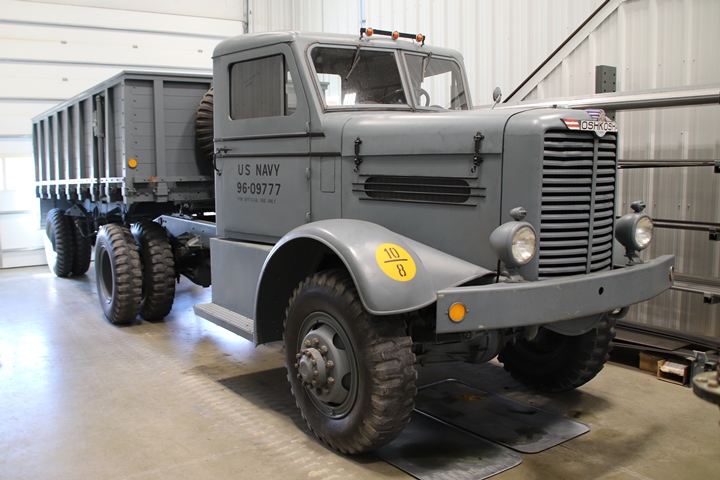
Things change. In 2023, the
Oorlogsmuseum at Overloon, The Netherlands
sold the W-709-C-T-5 to the National Museum of Military Vehicles in
Dubois, WY. Once I became aware that the W-709-C-T-5 was back home
in the United States, I made the trip to Dubois, WY to see this
one-of-a-kind truck. I had been procrastinating on making the trip
to the National Museum of Military Vehicles due to the time and distance
involved. The arrival of the W-709-C-T-5 at the museum convinced
me it was time to make the trip. There are twenty-one more photos
of this truck in the W-709-C-T-5 Navy Truck portion of this website.
Author's photo added 9-16-2023.
The Oshkosh Motor Truck Corporation did not
keep any retrievable records of its participation during World War Two. This
is typical of many companies as the war was just a brief interlude in
their normal business operations. This is acknowledged in the only
history of the company that was put together by the late Clarence Jungwirth
in his excellent and comprehensive book "A History of the Oshkosh Motor
Truck Corp." Mr. Jungwirth's book reflects the
lack of records and notes that the company built snow blowers and
wreckers for the war effort.
With the assistance of Jeff Lakaszcyck,
vintage truck historian and photographer, and Tim Wright, Oshkosh truck
historian, I have been able to put a lot of the puzzle pieces together
on what the Oshkosh Motor Truck Corporation built during World War Two.
The reader will note that this page still shows a level of uncertainty about some of the company's
war products. Hopefully, more information will be unearthed to help remove these
uncertainties.
One thing that is certain is where and how the
initial idea that eventually developed into the Oshkosh Motor Truck Corporation got its start. This is where the
story begins.
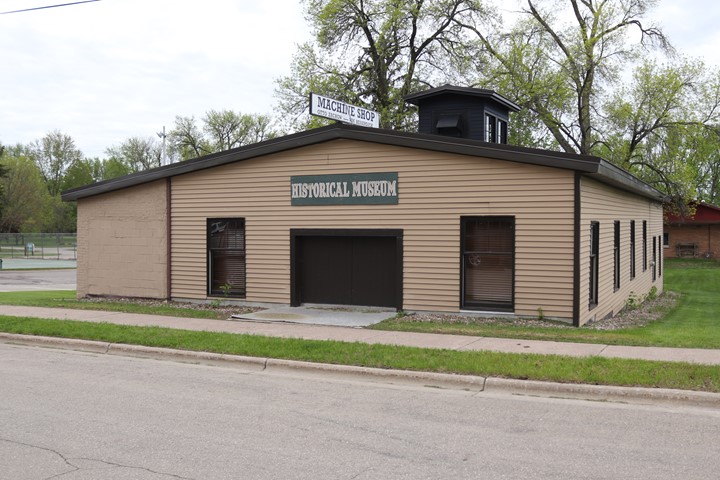
This former machine shop in Clintonville, WI
is where the concept of power to all four wheels, or four-wheel drive,
was conceived in 1908. This eventually led to the founding of the
Oshkosh Motor Truck Corporation nine years later. This is also
where the FWD Corporation began, which was the first manufacturer of
four-wheel drive vehicles. Author's photo.
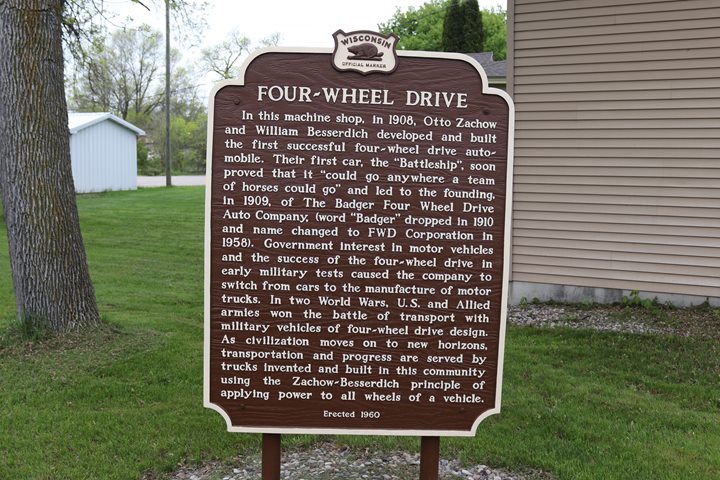
The information on the historical marker is
accurate as far as it goes. However, it does not mention that William Besserdich
left the Four Wheel Drive Auto Company and then formed what became
today's Oshkosh Corporation. But the sign is in Clintonville, WI,
home of FWD and the FWD Museum. When this historical marker was
erected in 1960, the two companies were competitors in a limited market.
FWD lost market share and eventfully purchased Seagrave and began making
fire apparatus in Clintonville. Oshkosh obtained several key military contracts
and became a dominant manufacturer of all wheel drive vehicles for the
military. Author's
photo.
In 1908 the Badger Four Wheel Drive Auto
Company, under the direction of Mr. Zachow and Mr. Besserdich, built the
first ever four-wheel drive vehicle named the "Battleship" as stated on
the historical marker. Another ten cars were built but the market
was not receptive to a four-wheel car at the time. Therefore, the
company moved into producing trucks, which was a path taken by several
other car companies early in the history of the automobile.
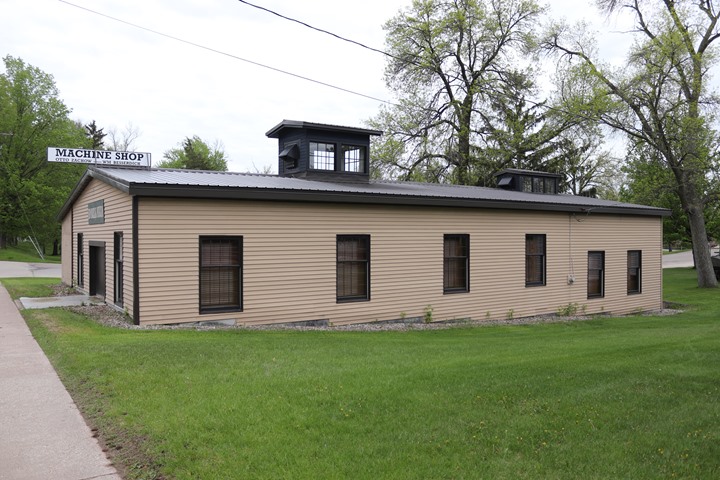
Today the machine shop where four-wheel and
all-wheel drive were invented is part of the FWD Seagrave Museum located
in Clintonville. Author's photo.
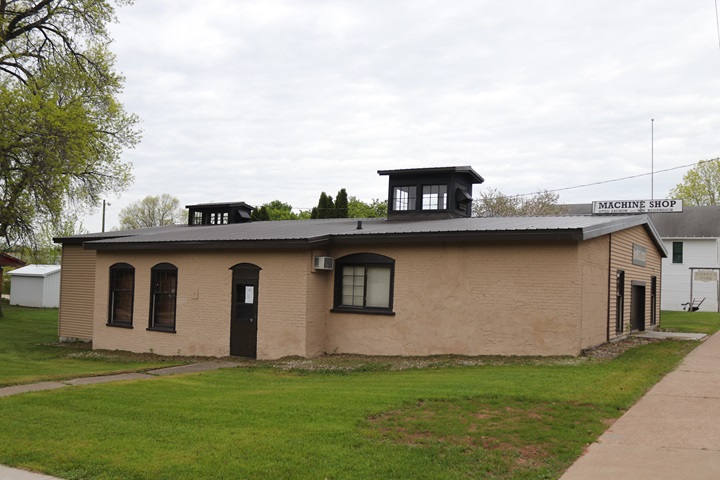
Today, four-wheel and all-wheel drive are
commonplace. Now four-wheel drive is pretty much standard equipment
on pickup trucks, and many SUVs are equipped with all-wheel drive.
For this to have happened, Otto Zachow and William Besserdich first
created the concept and initial design in this building. For those
of us who
drive trucks with four-wheel drive and SUVs with all-wheel drive, we are indebted to Mr. Zachow and
Mr. Besserdich. Author's photo.
Otto Zachow and William Besserdich were the
only persons in 1908 to own an automobile in Clintonville. One day
the two took several friends for a ride in their 1908 Reo and promptly
got struck in the muddy country road that was appropriate for horses but
not for the new automobile. The riders then assisted the pair in
getting the vehicle out of the mire and going again.
Getting stuck in the mud was fortuitous
because William Besserdich realized that not only was the vehicle pushed
from the rear but also pulled from the front. He realized that if
power could be applied to the front wheels to pull the vehicle, it would
be better able to negotiate the unpaved roads of the era. When
they
returned to the machine shop, he explained his idea to Otto Zachow and
the four-wheel drive concept was born.
Both Mr. Zachow and Mr. Besserdich left the
company they created. Otto Zachow left in 1912. William
Besserdich stayed another two years. Differences of opinion with the
company's president, Walter Owen, and an engineer, Mr. Battenberg,
caused his departure. In 1914 he sold his shares in the Four Wheel
Drive Auto Company and moved on.
William Besserdich then teamed up with
Bernhard Mosling, an established businessman in Clintonville. The
two formed the Wisconsin Duplex Auto Company in Clintonville and set up
shop in Mr. Mosling's mercantile store. However, the Four Wheel
Drive Auto Company dominated the business atmosphere in Clintonville.
Therefore, the first vehicle built by the fledgling company in 1917 was
a one-ton 4x4 built at the Andrews Motor Manufacturing under the
guidance of William Besserdich. This four-wheel drive truck was
named "Old Betsy."
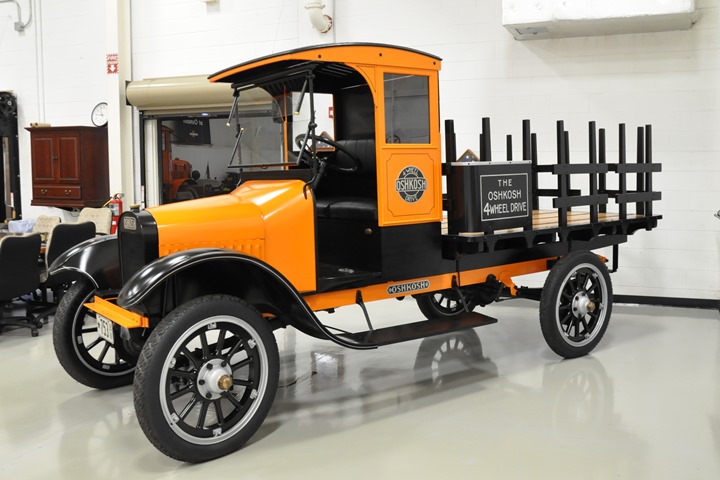
How cool is this? "Old Betsy" still
exists and is owned by the Oshkosh Corporation. Photo
courtesy of Tim Wright.
In 1917 the Wisconsin Duplex Auto Company
moved to Oshkosh, WI where the business environment was more friendly.
In honor of being welcomed into the community, Mr. Mosling and Mr.
Besserdich renamed the company The Oshkosh Motor Truck Manufacturing
Corporation. It has been in Oshkosh ever since and has been an
important source of jobs for the community after which it is named.
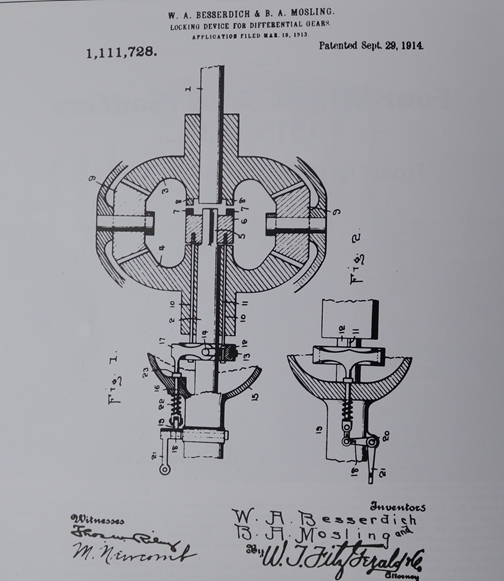
As part of the partnership in forming the
Wisconsin Duplex Auto Company, William Besserdich sold his part of this
patent to Bernhard Mosling for $2,000. Patent 1,111,728 issued
September 29, 1914, shows Mr. Mosling as a co-inventor.
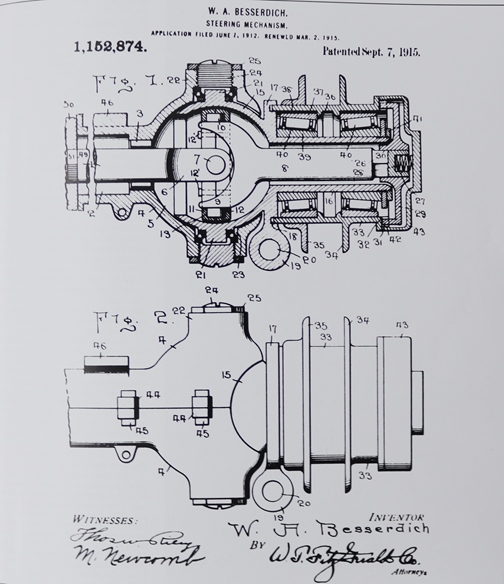
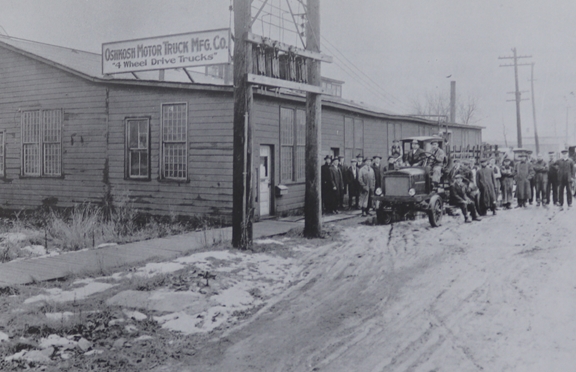
The new company's first factory in the town
of Oshkosh was at the corner of High and Forest Avenues.
Today this area is the location of the University of Wisconsin-Oshkosh.
Forest Avenue no longer exists.
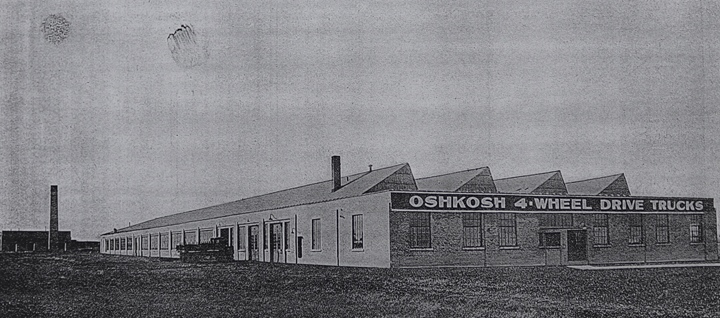
The original factory was not adequate, so
this new construction was completed in December 1920 at the intersection
of Oregon Street and 23rd Avenue in Oshkosh. There are no trees nor shrubbery in front of it.
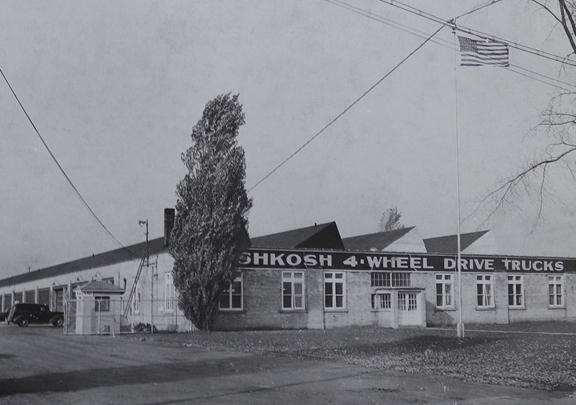
This more recent photo shows a tree and new windows along the front of
the building.
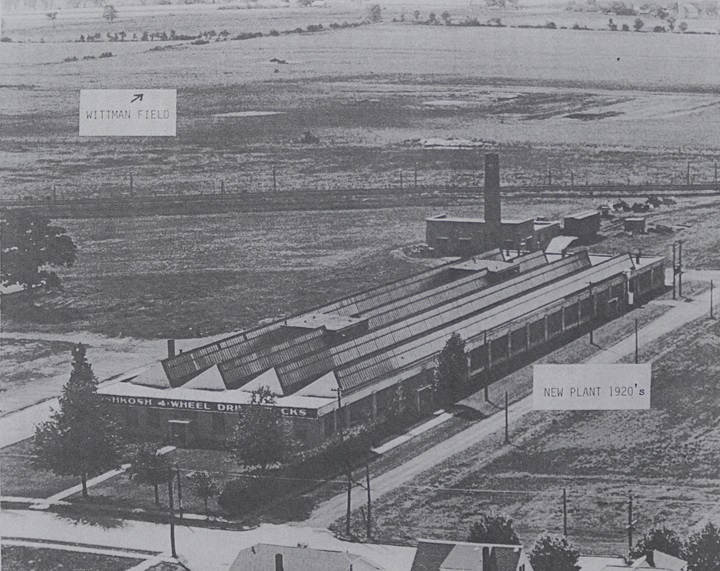
Later, the plant had trees and
shrubbery around it. This picture represents the Oshkosh plant as
it looked during World War Two. The photo is looking
southwest with Oregon Street running north and south in front of the
building. Those who have been to the EAA Convention every July in
Oshkosh will note how Wittman Field has gone from a grass field to the
modern airport it is today.
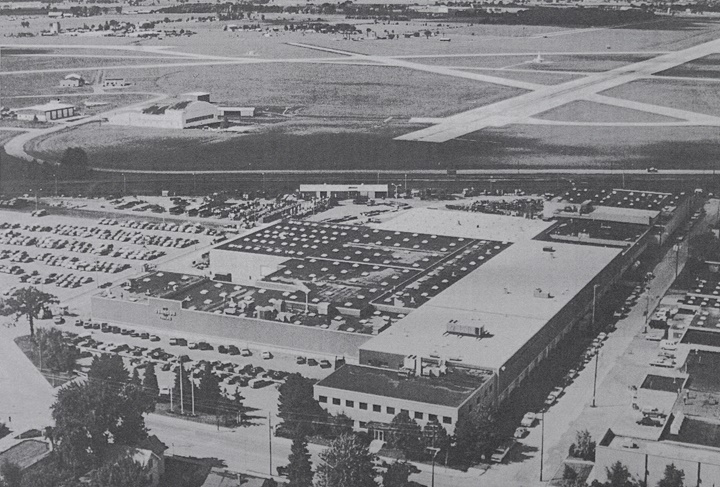
The plant in 1987. A new office building has been added, as it now
extends out to Oregon Street and the roof has been changed. The
power plant is gone, and a new factory addition has been added to the
south side of the building. Wittman Field is now looking like the
modern airport visitors see when visiting the EAA convention. This
building still exists along with a new factory that has been built to
the south of this area. Trucks have been built in this location
for 100 years.
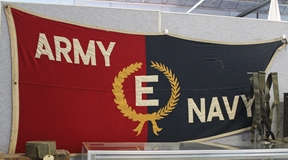
Oshkosh Motor Truck, Inc. won the Army-Navy
"E" Award one time during World War Two.
Oshkosh Motor Truck, Inc. World War Two
Products: Oshkosh Truck is only officially credited with
providing 151 vehicles to the U.S. military in World War Two.
These are the two different groups of trucks shown in Table 1 which
totaled 151 7-1/2-ton trucks accepted by Army Ordnance on behalf of the
U.S. Navy. Other historical sources indicate that the U.S. Army
Corps of Engineers
purchased 75 Oshkosh 7-1/2-ton 4x4s for snow blowers. These were
W-709-C15s.
Table 2 shows that between 1940 and 1945
Oshkosh Motor Truck built 1,255 trucks. Subtracting out the 151
that were built for the U.S. Navy and the 75 for the Corps of Engineers
still leaves 1,029 that also could have been built for the military.
The July 1944 advertisement below "War is still our Number One Job"
states that the War Production Board allowed the company to
build a limited number of civilian trucks. This implies that all
of the trucks built from early 1942, when civilian truck production ceased, up
through mid-July 1944 were for military use only. In many cases,
these were slightly modified W-series trucks ordered as wreckers or as
snow blowers for military air fields.
The U.S. Army "Summary Report of Acceptances,
Tank-Automotive Material, 1940-1945" is the most complete and
comprehensive record of vehicles produced during World War Two.
However, it is only a small part of the story. The
U.S. Navy had its own procurement system for purchasing equipment and
vehicles of which there are no known records. Both the USAAF and
the U.S. Army Corps of Engineers also ordered their own vehicles outside
of the Army Ordnance purchasing. What is really strange is that
the 151 W-series trucks ordered for Navy use against Army Corps of
Engineering specifications were recorded by Army Ordnance in its
summary.
Early in World War Two, the USAAF purchased a number of W-709 Oshkosh
chassis with Gar Wood 5-ton swinging booms. These were standard
W-709 chassis which had been modified for military use with a robust
brush guard to protect the headlights and radiator. These were
being used by the USAAF in the South Pacific in late 1942 and in England
at
about the same time.
There is also evidence that early in World War
Two the U.S. Navy ordered an undetermined number of 7-1/2-ton, 4x4
W-709-C-T-5 tractors. The Army Corps of Engineers purchased snow blowers
throughout the war to keep airfields in operation year around. It
also used Oshkosh dump trucks as snow plows during the war.
Table 1 - Oshkosh
Motor Trucks, Inc. Vehicles
Accepted by Detroit Ordnance, US Army
The information below comes from "Summary Report of
Acceptances, Tank-Automotive Material, 1940-1945."
Published by Army Services Forces, Office, Chief of
Ordnance-Detroit, Production Division, Requirements and
Progress Branch
January 21, 1946. |
|
Type |
Oshkosh Model |
1941 |
1942 |
1943 |
1944 |
1945 |
Total |
| Truck, 7-1/2-ton,
4x4, Chassis |
W-709-C-T-5 |
|
|
|
75 |
|
75 |
| Truck, 7-1/2-ton,
4x4, Dump |
? |
|
|
|
76 |
|
76 |
| Total |
|
|
|
|
151 |
|
151 |
These 151 trucks were all built for the
U.S. Navy. The Summary Report of Acceptances document clearly
states this.
One difference between the standard W-series trucks and
those ordered to U.S. Army Corps of Engineering standards was the engine.
Normal W-series trucks were powered by Hercules RXC engines with 128 hp. The
Army Corps of Engineers instead specified Continental 22R engines with
145 hp.
|
Table 2 - Oshkosh
Motor Trucks, Inc. Vehicles Built During World War Two 1940-1945 |
|
Type |
1940 |
1941 |
1942 |
1943 |
1944 |
1945 |
Total |
| Total Trucks Built |
110 |
120 |
157 |
245 |
417 |
326 |
1,255 |
| Serial Numbers |
1272-1381 |
1382-1501 |
1502-1658 |
1659-1903 |
1904-2320 |
2321-2606 |
|
|
Table 2A - Oshkosh
Motor Trucks, Inc. Vehicles Built During World War Two 1942-1945 |
|
Type |
1942 |
1943 |
1944 |
1945 |
Total |
| Total Trucks Built |
157 |
245 |
417 |
326 |
1,145 |
| Serial Numbers |
1502-1658 |
1659-1903 |
1904-2320 |
2321-2606 |
|
|
Table 3 - Oshkosh Motor Trucks,
Inc.'s Major World War Two Contracts
The information below
comes from the "Alphabetical Listing of Major War Supply
Contracts, June 1940 through September 1945." This was
published by the Civilian Production Administration,
Industrial Statistics Division. This table added
11-6-2022. |
|
Product - Customer |
Contract Amount |
Contract Awarded
|
Completion
Date |
| Trucks - Army
Corps of Engineers |
$88,000 |
12-1941 |
2-1942 |
| Trucks Tractor -
Navy |
$293,000 |
5-1942 |
10-1942 |
| Trucks - Army
Corps of Engineers |
$133,000 |
8-1942 |
10-1942 |
| Trucks - Army
Corps of Engineers |
$122,000 |
9-1942 |
11-1942 |
| Trucks - Army
Corps of Engineers |
$92,000 |
2-1943 |
5-1943 |
| Chassis Truck -
Army Corps of Engineers |
$599,000 |
4-1943 |
10-1943 |
| Trucks - Army
Corps of Engineers |
$66,000 |
5-1943 |
8-1943 |
| Truck Chassis -
Army Corps of Engineers |
$69,000 |
5-1943 |
7-1943 |
| Dump Trucks -
Army Corps of Engineers |
$651,000 |
7-1943 |
11-1943 |
| Truck Chassis -
Army Corps of Engineers |
$56,000 |
9-1943 |
12-1943 |
| Truck Chassis -
Army Corps of Engineers |
$1,264,000 |
10-1943 |
9-1944 |
| Trucks - Army
Corps of Engineers |
$885,000 |
8-1944 |
6-1945 |
| Truck Chassis -
Army Corps of Engineers |
$821,000 |
4-1945 |
11-1945 |
| Total |
$5,099,000 |
|
|
Table 3 shows that the company had
$5,099,000 in total major contracts. With the exception of one
Navy contract for $293,000 worth of trucks, the remainder of the
contracts were for the Army Corps of Engineers. However, several
of the Army Corps of Engineers' contracts provided dump trucks and truck
chassis to the U.S. Navy.
Table 2 shows that the Oshkosh Motor
Truck Corporation built 1,255 trucks between 1940 and 1945.
However, Table 3 shows that major contracts were not awarded to the
company until December 1941 with production production completed until
November 1945. Table 2A shows that the Oshkosh Motor Truck
Corporation produced 1,145 trucks between 1942 and 1945. Dividing
this into the total value of the major contracts from Table 3 of
$5,099,000 gives an average cost of $4,453 for each truck Oshkosh
produced during World War Two.
Oshkosh Wreckers in World War Two:
The USAAF purchased W-709 series trucks early or even before World War
Two for use as 7-1/2-ton 4x4 wreckers. These were powered by a
Hercules RXC six-cylinder engine producing
128 hp. The trucks were quickly modified with a brush guard for
the radiator and headlights. A Gar Wood five-ton crane along with
stabilizing jacks were added. The truck was also equipped with a
fifth-wheel for pulling a trailer. With these additions, Oshkosh
Motor Truck was able to provide much needed heavy-duty wreckers for the
military early in World War Two.
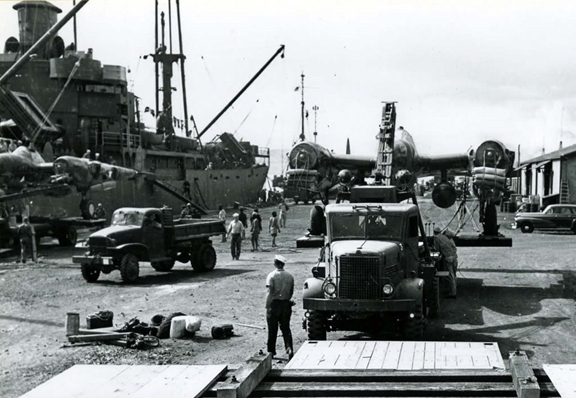
This is the port of Noumea, New Caledonia in
the southwest Pacific, which is 700 miles east of Australia.
American forces occupied it in 1942 to prevent the Japanese from using
it
as a base during the war. In September 1942, Lockheed P-38 fighters
were transported to the docks at Noumea. Two P-38s have been
loaded onto trailers pulled by Oshkosh W-709 wreckers. The
radiator and headlight brush guard is visible on the wrecker in the right
of the photo. The Oshkosh nameplate and insignia are also visible
on vehicle. There are three lights attached to a bracket on the
cab and a blackout light on the passenger side headlight. Also in
this photo is a Chevrolet 1-1/2-ton 4x4 dump truck. Image courtesy of Jeff Lakaszcyck.
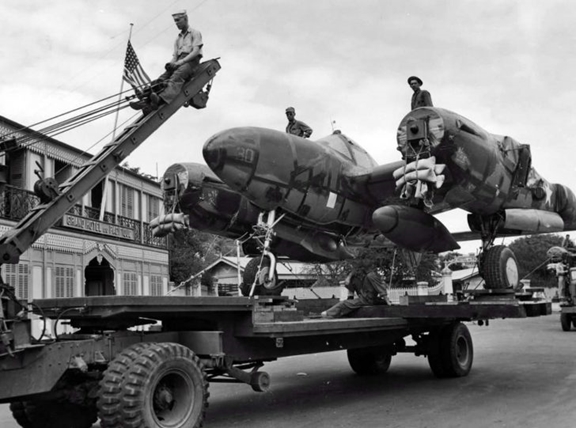
P-38 number thirty is being pulled through
the streets of Noumea on the way to the American airfield outside of town.
The seams on the aircraft have been taped to keep the salt air from
corroding the inside of the aircraft during ocean transit. Sandbags
have been added to the front of the engine nacelles to give the aircraft
the proper balance.
An American sailor is on
the Gar Wood crane while American airmen ride on the center section of
the P-38. The rear section of the W-709 chassis has the fifth
wheel located behind the
crane. Image courtesy of Jeff Lakaszcyck.
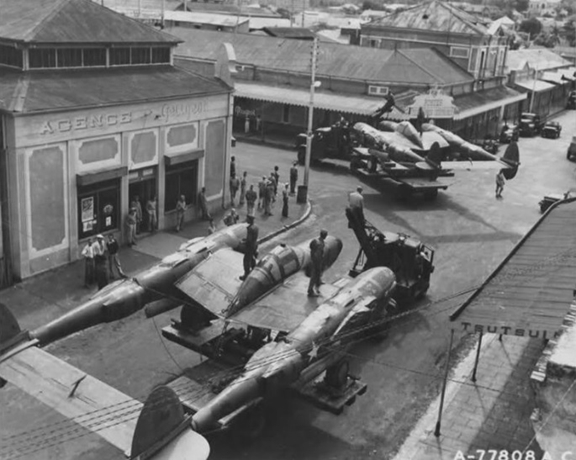
An Oshkosh W-709 Army Air Force wrecker with
its P-38 in tow is negotiating a turn in downtown Noumea while another
waits its turn. Image courtesy of Jeff Lakaszcyck.
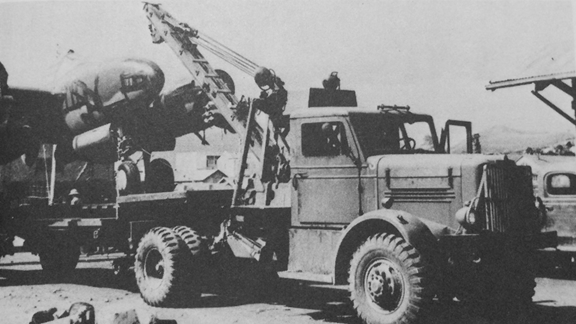
This W-709 wrecker arrived at the
airfield with its P-38. The P-38s will be lifted off the trailers
and then re-assembled by adding the wings and engines by Army Air Force
mechanics. Note that there are
three small lights on a bracket on top of the cab and a blackout light
is on
the right headlight. Image courtesy of Jeff Lakaszcyck.
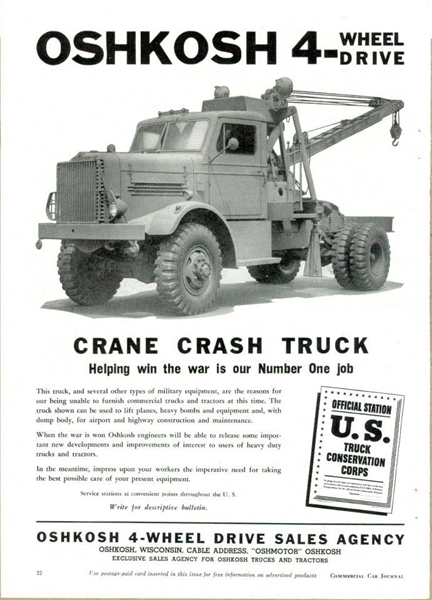
This advertisement from the "Commercial Car Journal" contains the best
photo of an Oshkosh W-709-C15 wrecker known to exist. This shows
the brush guard, the blackout light on the driver's side of the vehicle,
and the three lights on the cab. It also has a running light on
the fender. This photo and those from New Caledonia show what
appear to be turn signals on top of the fenders. Image courtesy of
Tim Wright.
The Oshkosh W-709-C-15 Snow
Blower:
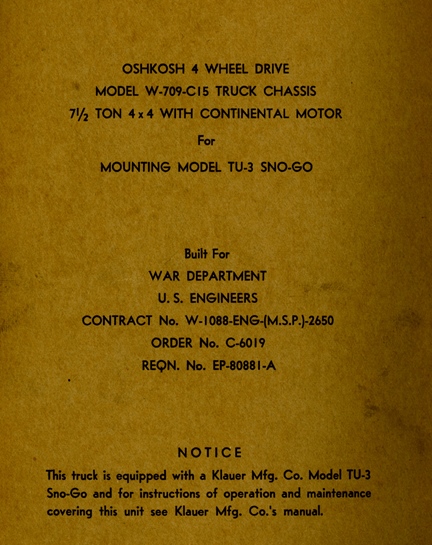
This is the cover of the Operation and Maintenance
Manual for the Oshkosh W-709C-15 mounting Model TU-3 Sno-Go snow blowers
ordered by the Army Corps of Engineers. There is no date for the
manual, but the Engineers appeared to have an open contract with Oshkosh
for trucks, as the contract is the same as the one shown for tractor trucks for
the U.S. Navy shown below.
The title from the Operation and Maintenance Manual specifies a
Continental engine. This is no doubt the 22R that is specified in
the Operation and Maintenance Manual for Navy trucks below. The
normal engine for the W-709 was the Hercules RXC six-cylinder engine
producing 128 hp. The Army Corps of Engineers wanted the 145 hp in
the Continental 22R engines for its trucks purchased from Oshkosh.
This is the only
documented evidence for the use of snow blowers for the military.
A historical source indicates that in 1944 the U.S. Army Corps of
Engineers ordered 75 units for this purpose. This may be the
documentation for that order or a previous one. The Army Engineers
would have been purchasing snow blowers, even before the war started,
with the buildup of military bases in northern climates. Image
courtesy of Tim Wright.
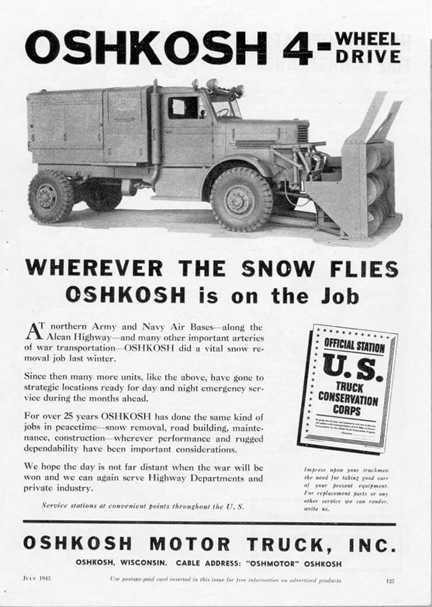
Image courtesy of Tim Wright.
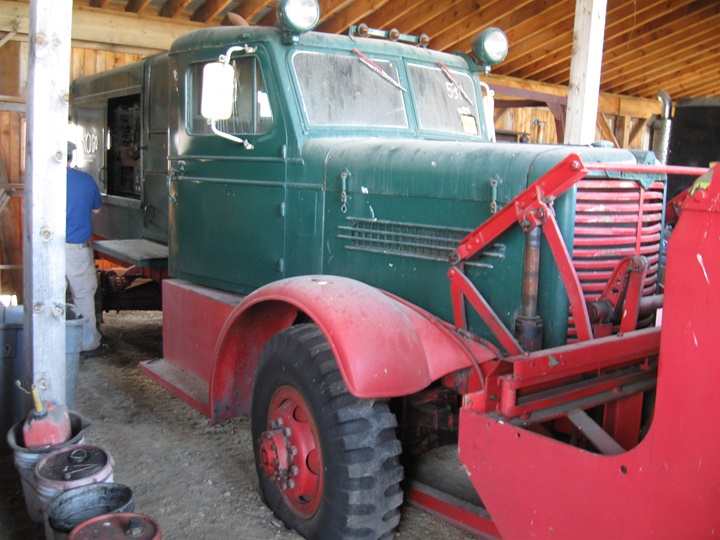
This is a former 1945 U.S. Army Corps of
Engineers W-709-C15 serial number 2472. Table 2 indicates this
truck was built in 1945. It may well be from the previously
mentioned 1944 order
or another later order. The Klauer Manufacturing Sno-Go was built
in November 1943. This truck is owned by the Gushee family and was
photographed by Jeff Lakaszcyck.
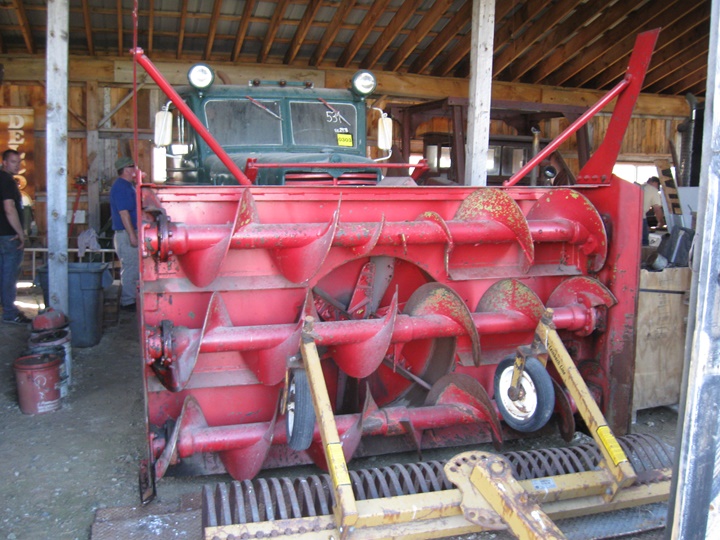
Photo courtesy of Jeff Lakaszcyck.
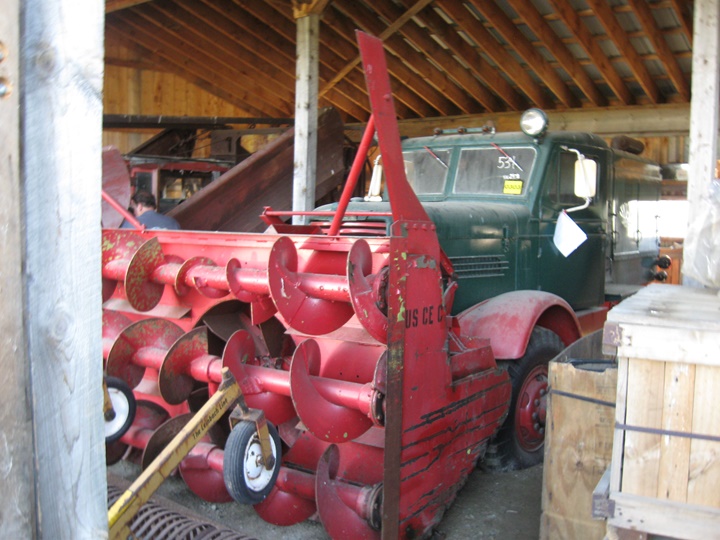
The snow blower has "US CE" painted on it.
There is also a bracket with three amber lights on it, as seen on several of
the USAAF wreckers. Photo courtesy of Jeff Lakaszcyck.
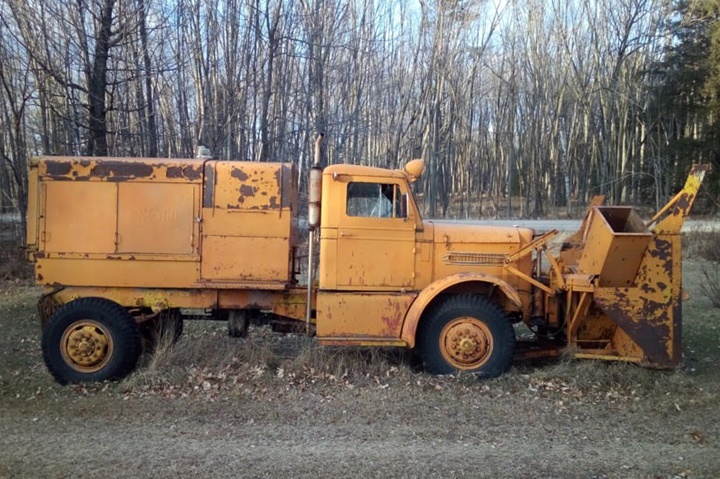
This Oshkosh W-709 snowplow was purchased by
the U.S. Corps of Engineers in 1943. Image courtesy of Tim Wright
added 1-10-2021.
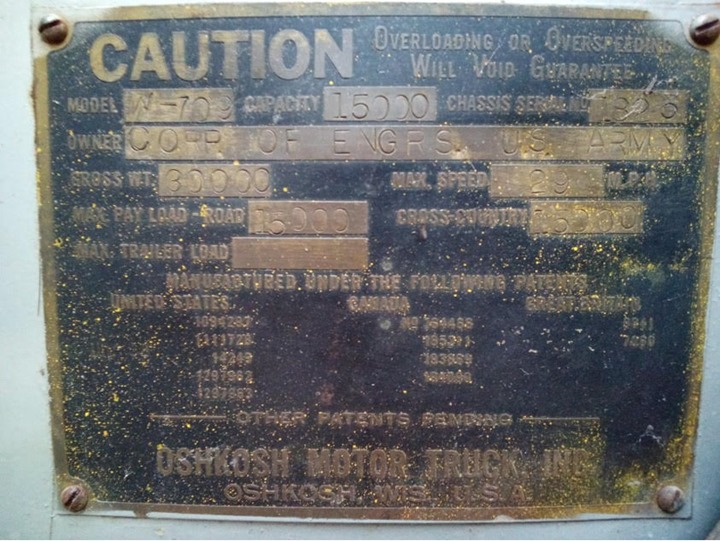
This truck is serial number 1826.
Note the top speed is 29 mph. Image courtesy of Tim Wright added
1-10-2021.
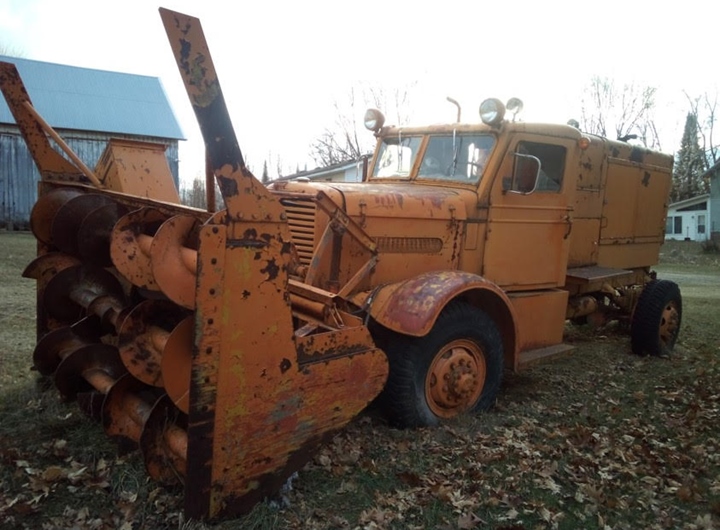
Image courtesy of Tim Wright added
1-10-2021.
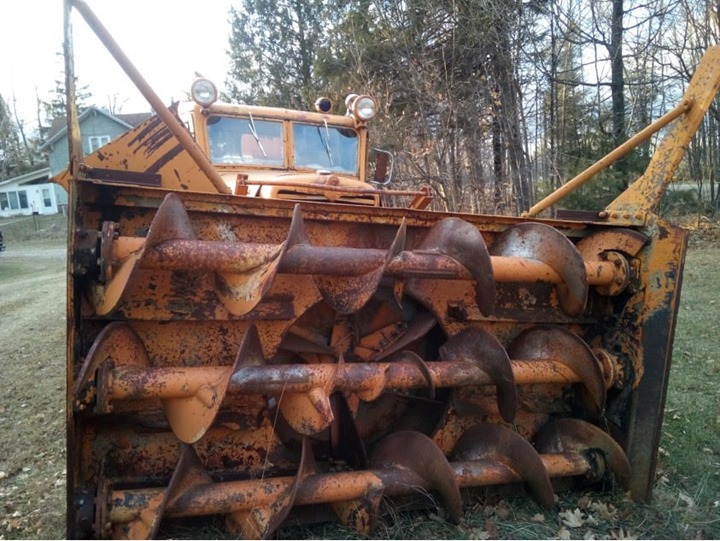
Image courtesy of Tim Wright added
1-10-2021.
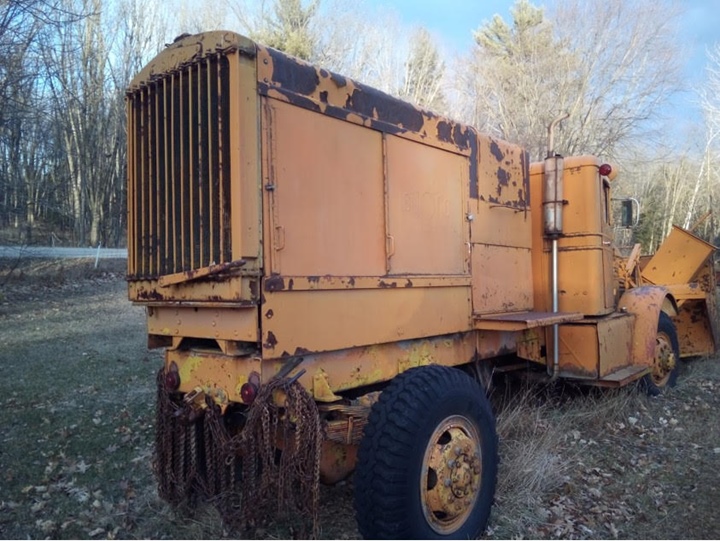
Image courtesy of Tim Wright added
1-10-2021.
The Oshkosh W-709-C-T-5 U.S. Navy Tractor
Truck: There is more documentation and current photos on this
World War Two Oshkosh truck than any of the others it built for the
military during World War Two. Several pages of the Operation and
Maintenance Manual for the vehicle are shown below.
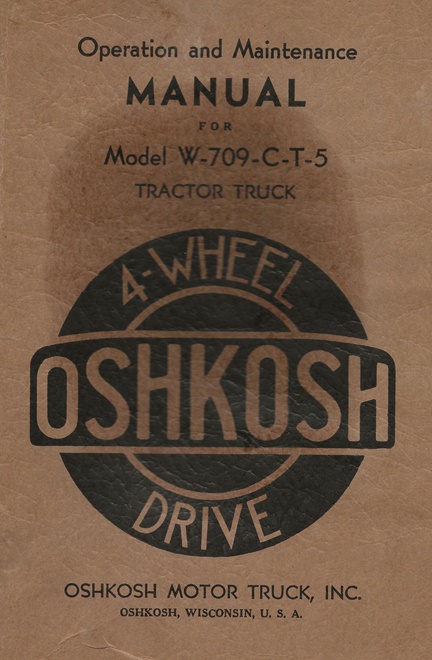
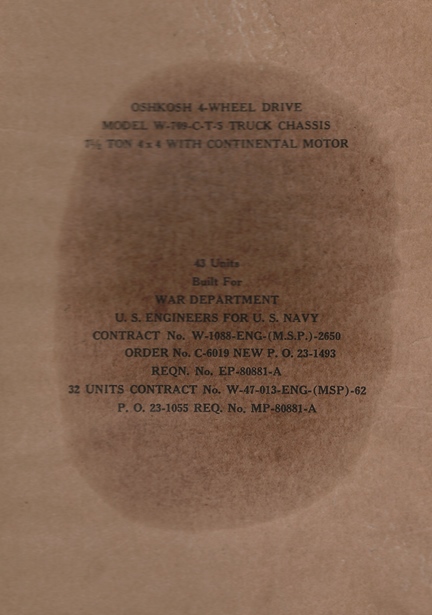
There were two contracts for this vehicle.
One for 43 units and one of 32, equaling the 75 accepted and noted in
Army Ordnance records and tabulated in Table 1.
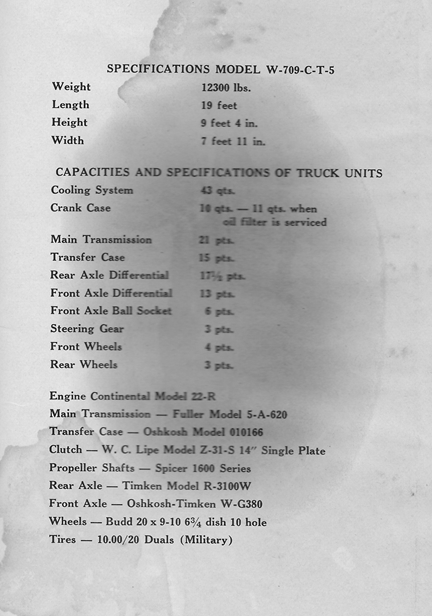
The specified engine is a Continental 145 hp 22R, not the
normal RXC engines used in the W-Series trucks. Oshkosh built its
own transfer case. The trucks had Ross Gear and Tool
twin lever, twin cam follower, T-series steering gears, and Auto-Lite
electrical systems.
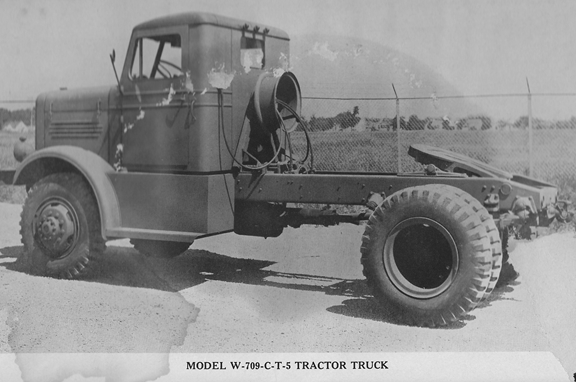
The Oshkosh Motor Truck W-709-C-T-5.
Note the type of side vents for the engine on this vehicle and that
there is a blackout light mounted to the headlight.
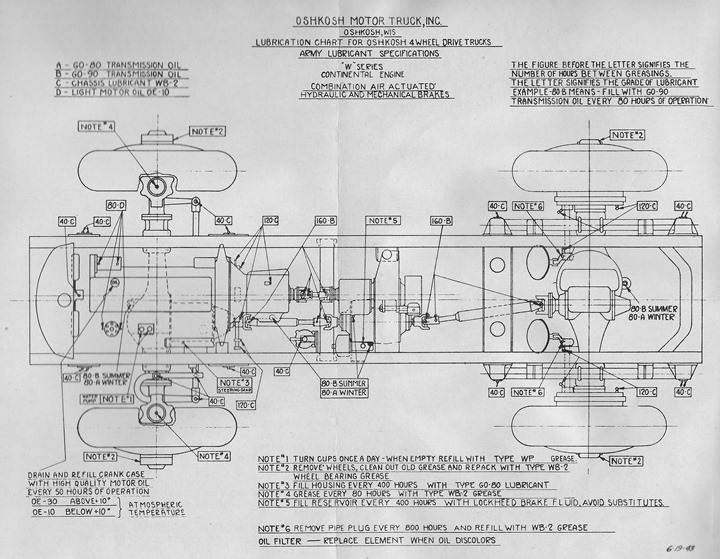
This drawing not only shows the lubrication points but the layout of
the drive train. This is a generic drawing, as the W-709-C-T-5 had twin wheels on the rear
axle.
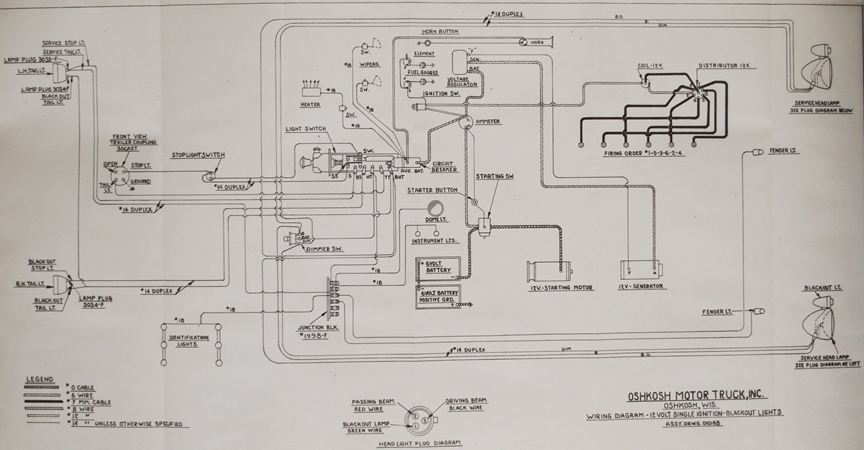
The electrical wiring is simple and straight forward. The cranking
motor, generator, regulator, distributor, and coil were provided by
Auto-Lite. The drawing shows that both headlights have blackout
lamps on them.
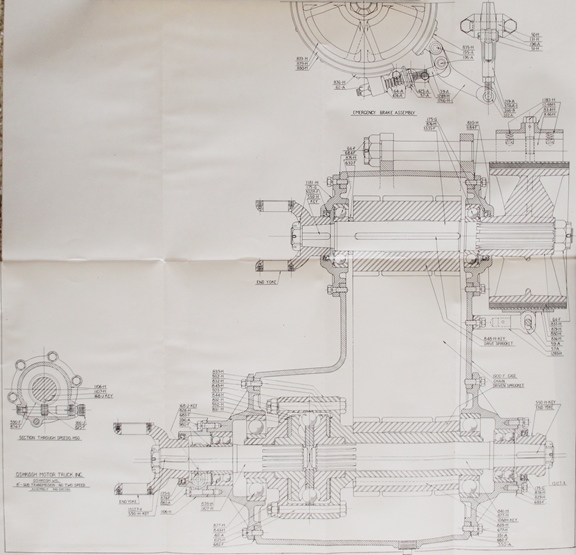
This is the Oshkosh-produced transfer case.
It is described as an 8-inch sub-transmission, two-speed assembly number
010166.
The U.S. Navy Oshkosh W-709-C-T-5 Tractor
Truck at the National Museum of Military Vehicles in Dubois, WY:
Below are nineteen of my photos of this vehicle inside and outside
of the museum's restoration shop. If I was going to drive 1,493
miles one way to see this truck, I was not going to take one or two
photos of it. I was going to photo-document this vehicle to the
best of my ability. Unlike many of the trucks and armored vehicles
the museum owns, this one will not be put on display. Because this
is an operational vehicle, it will be stored and then brought out for
parades during holiday events in Dubois. I was lucky enough to
find this vehicle still in the restoration shop, as it was awaiting the
replacement of the driver's side door window.

This truck was one of 75 ordered by the Army
Corps of Engineers on behalf of the U.S. Navy. It was accepted for
service in 1944. Author's photo added 9-16-2023.
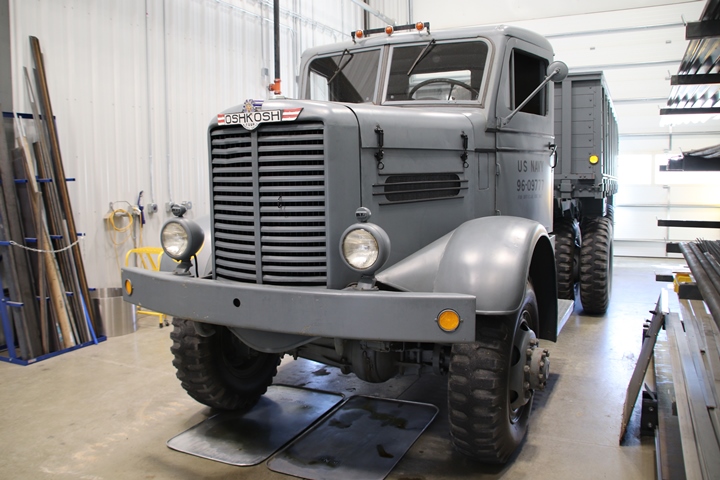
Author's photo added 9-16-2023.
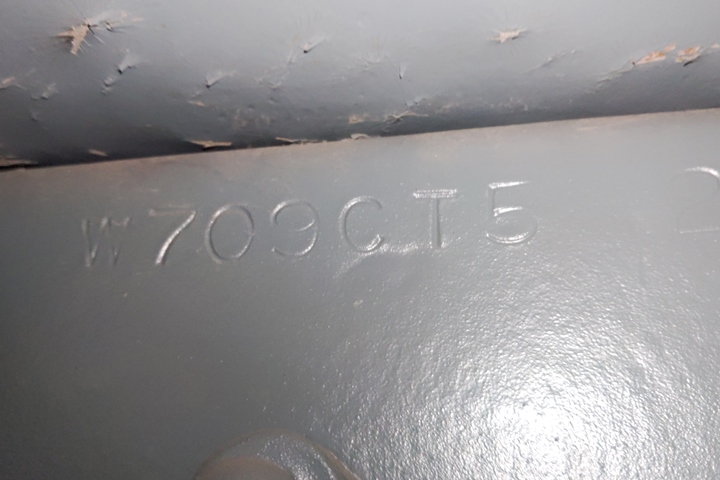
I could not find a data plate on the vehicle
and I forgot to look for the serial number on the frame. After
returning home Mr. Tim Wright, Oshkosh truck historian, informed me that
the serial number would most likely be located on the frame in the front
right wheel well. I contacted Mr. Guy Lavoie in the restoration
shop and requested that he see if he could find the serial number.
He was successful. This image shows the model number on the frame.
Photo courtesy of Mr. Guy Lavoie added 9-16-2023.
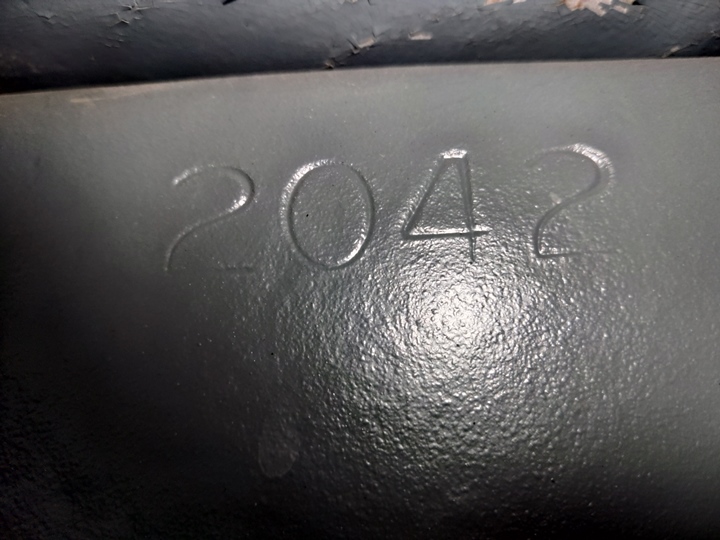
This Oshkosh W-709-C-T-5 is serial number
2042 which indicates that this truck was built in 1944. The
Oshkosh Motor Truck Company built serial numbers 1904 through 2320 in
1944. Photo courtesy of Mr. Guy Lavoie added 9-16-2023.

Author's photo added 9-16-2023.
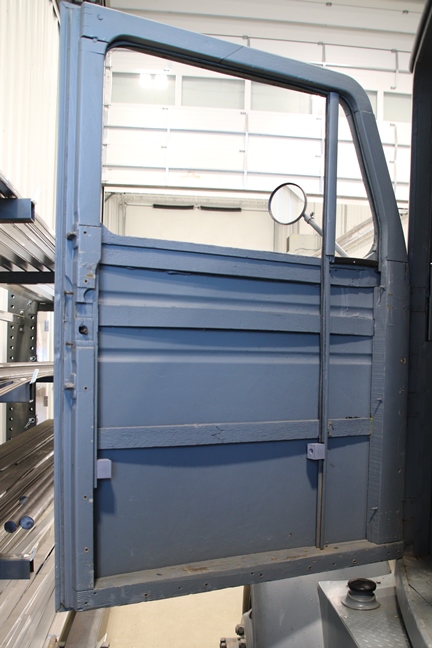
The glass in the driver's side door was
broken upon arrival from the Netherlands. The museum was in the
process of having the glass cut for replacement. Author's photo
added 9-16-2023.
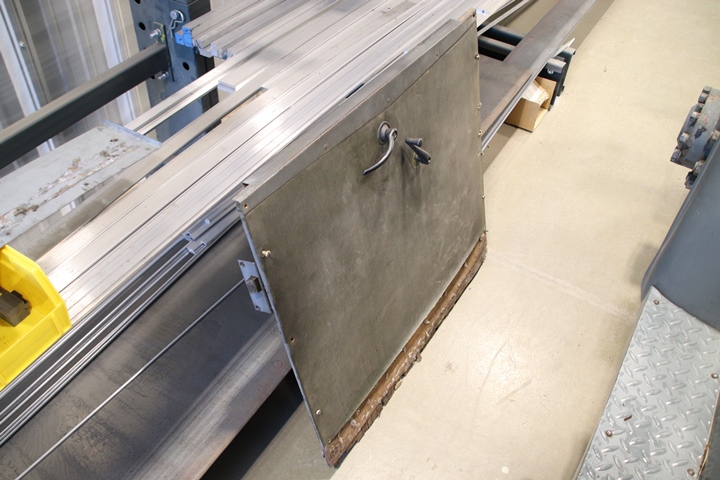
This is the inside panel of the driver's
side door. Author's photo added 9-16-2023.
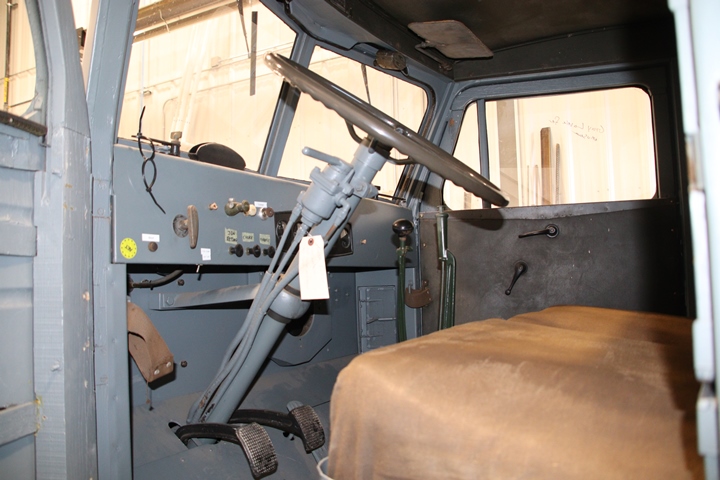
Author's photo added 9-16-2023.
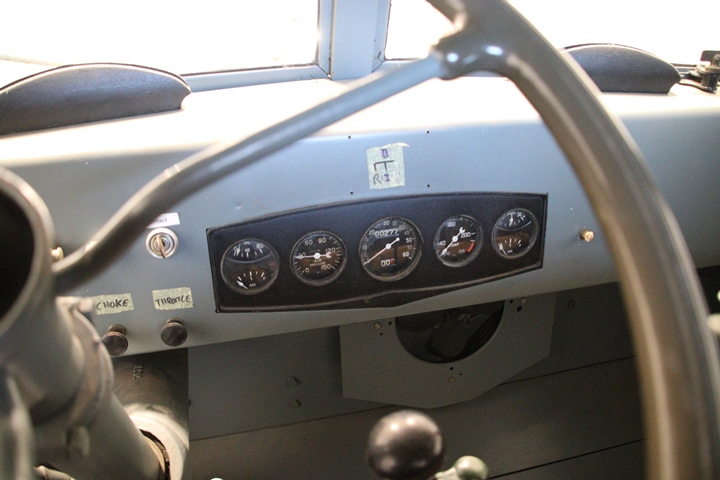
Author's photo added 9-16-2023.
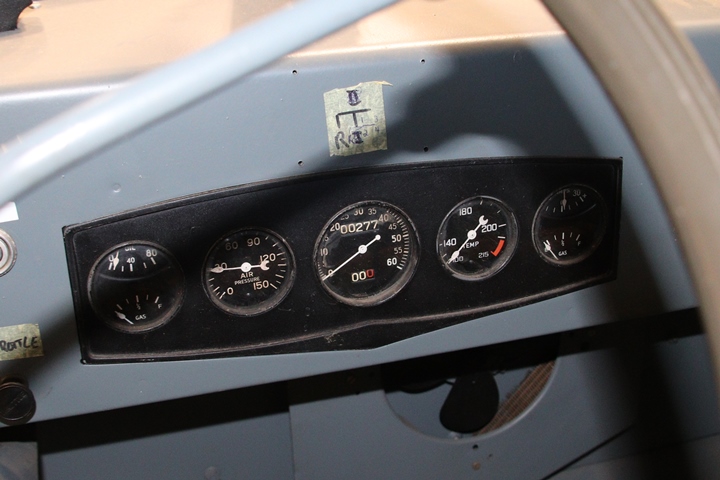
The odometer has 277 miles on it.
Author's photo added 9-16-2023.
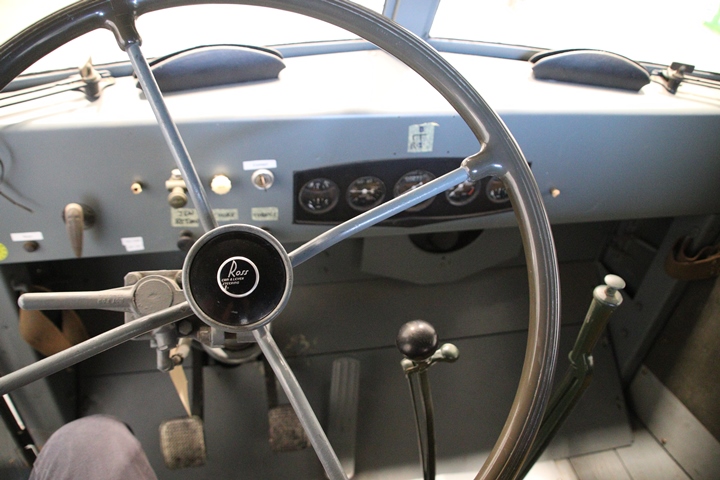
The Oshkosh W-709-C-T-5 came equipped with a
Ross Gear of Lafayette, IN cam and lever steering gear system.
Author's photo added 9-16-2023.
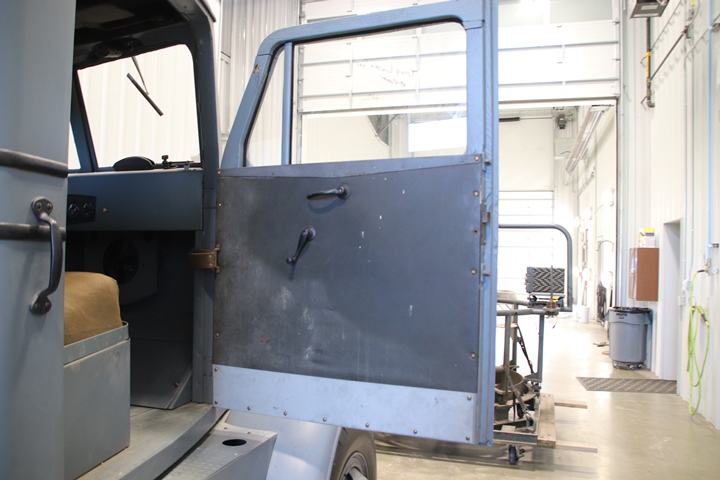
This photo shows the passenger side door
with the panel installed. Note the leather strap that keeps the
door from opening too far. Author's photo added 9-16-2023.
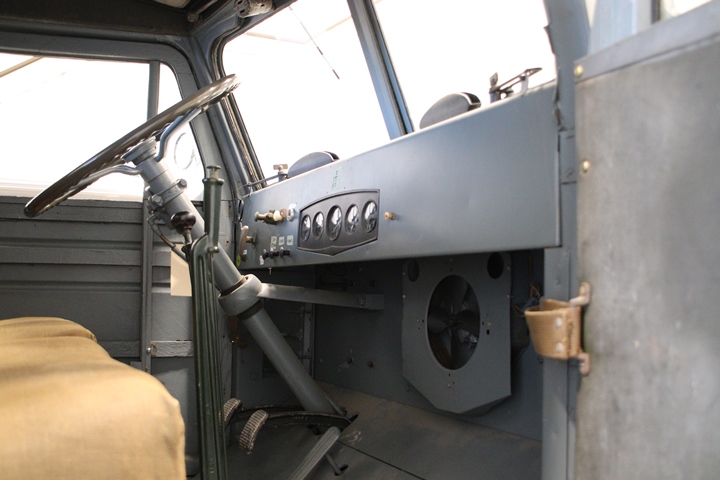
Author's photo added 9-16-2023.
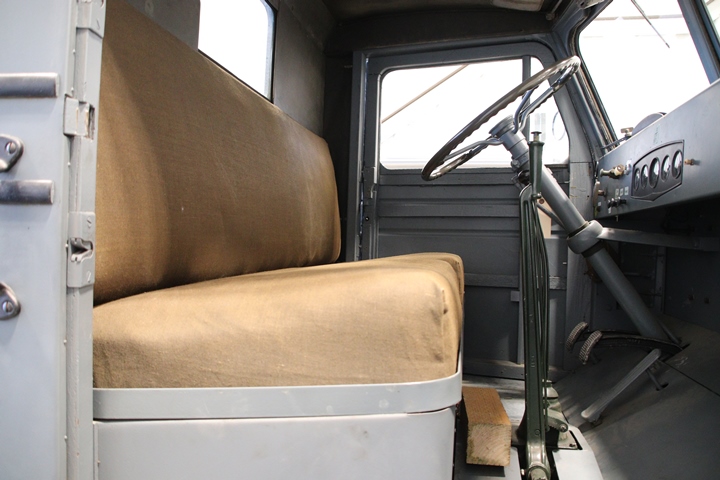
Author's photo added 9-16-2023.
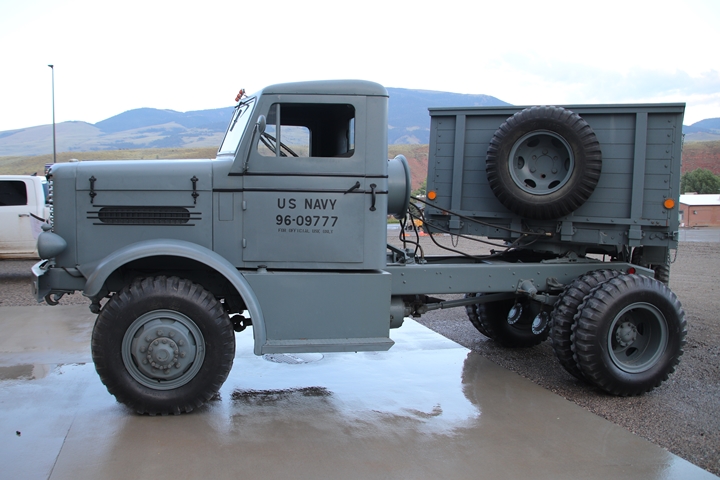
As noted previously, this is an operational
truck. Mr. Guy Lavoie backed the truck outside for me.
Author's photo added 9-16-2023.
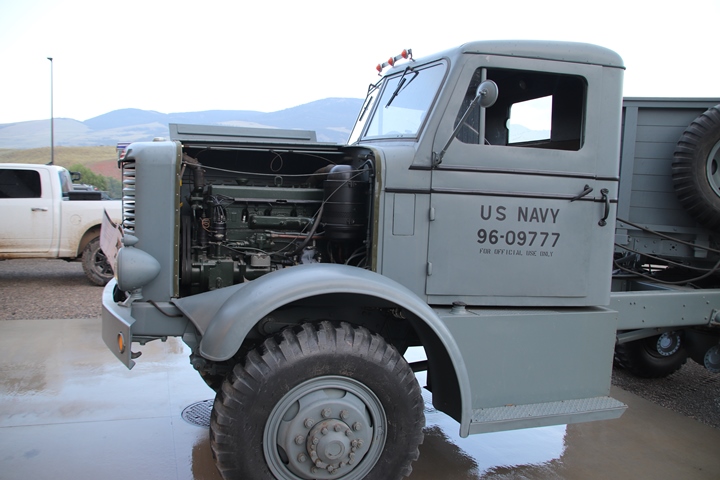
Author's photo added 9-16-2023.
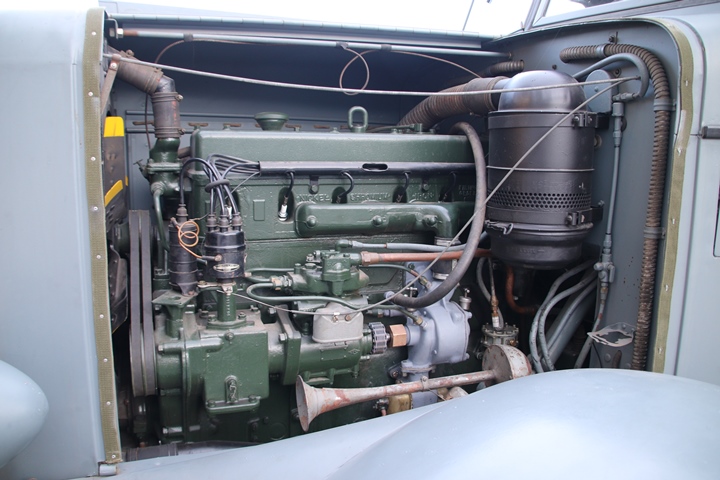
Author's photo added 9-16-2023.
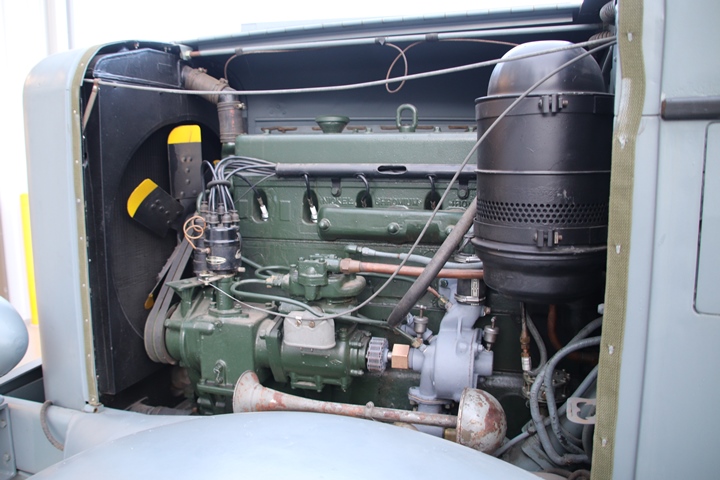
Author's photo added 9-16-2023.
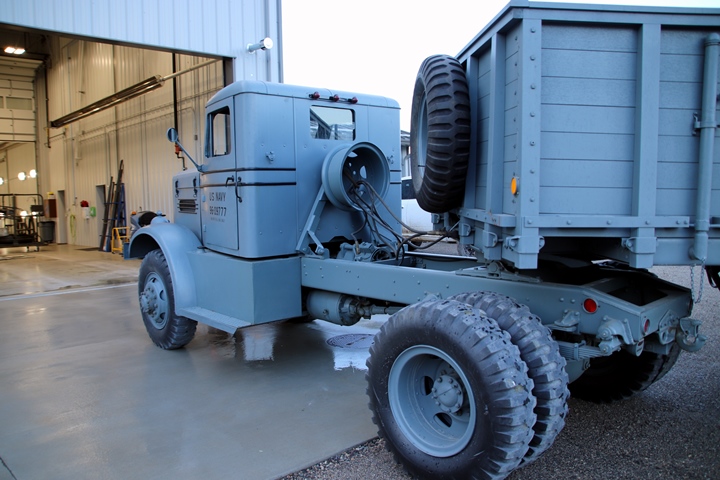
Author's photo added 9-16-2023.
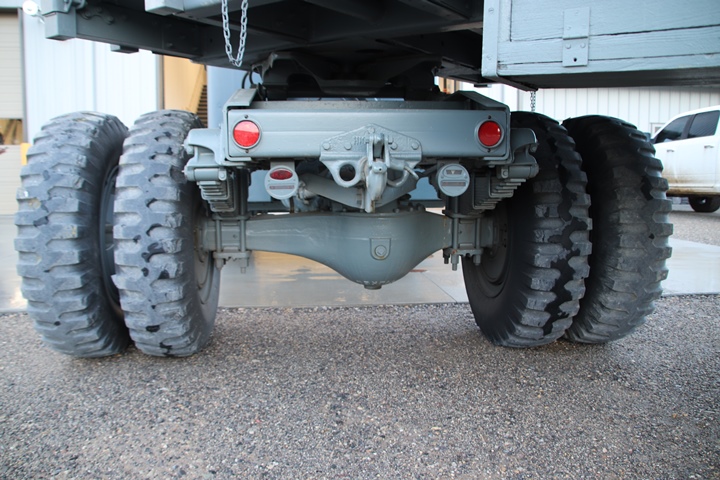
Author's photo added 9-16-2023.

This truck and trailer are two of 500
vehicles owned by the National Museum of Military Vehicles. The
museum staff showed great hospitality during my visit and went out of
their way to assist me. I especially want to thank Mr. Guy Lavoie,
restoration shop supervisor, for taking time out of his busy work
schedule to be my guide for a day at the museum. Author's photo
added 9-16-2023.
The Oshkosh W-709 U.S. Army Corps of
Engineers Dump
Truck: This World War Two era U.S. Army Corps of Engineers
dump truck also did double duty as a snow plow. This particular
truck was part of a large estate auction of 400 vehicles held in Kansas in
2018. While most of the vehicles auctioned off were civilian cars
and trucks, there was also a half-track and Autocar U-7144 in the
collection.
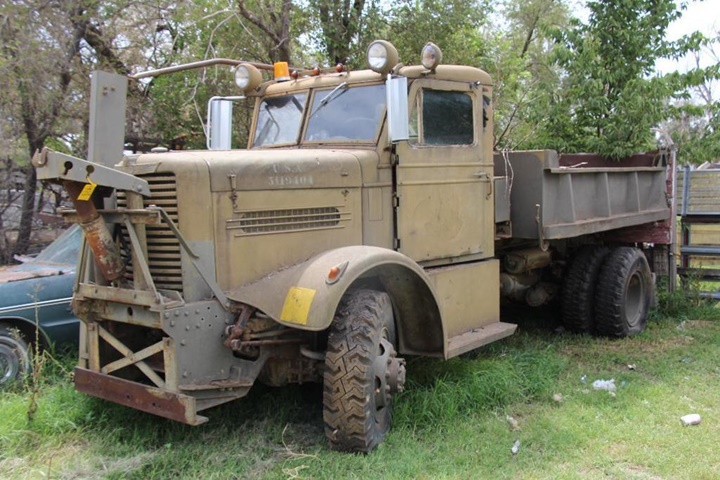
The truck still has its military paint
with USA registration number on it. It looks to be in relatively
good shape, considering it is almost eighty years old and has spent some
time outside. Photo via Jeff Lakaszcyck.
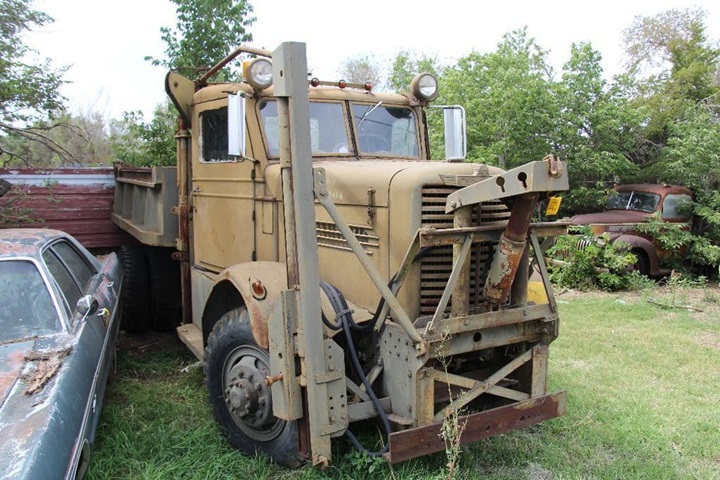
Photo via Jeff Lakaszcyck.
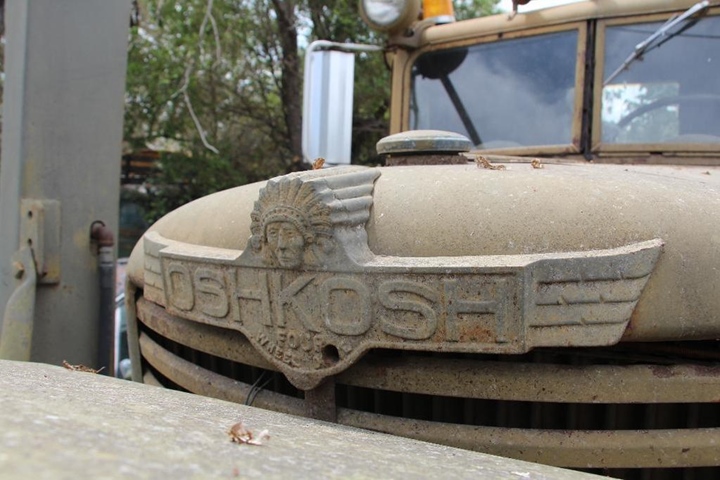
The Corps of Engineers required the name
plate to be painted the same as the rest of the truck. Photo via Jeff Lakaszcyck.
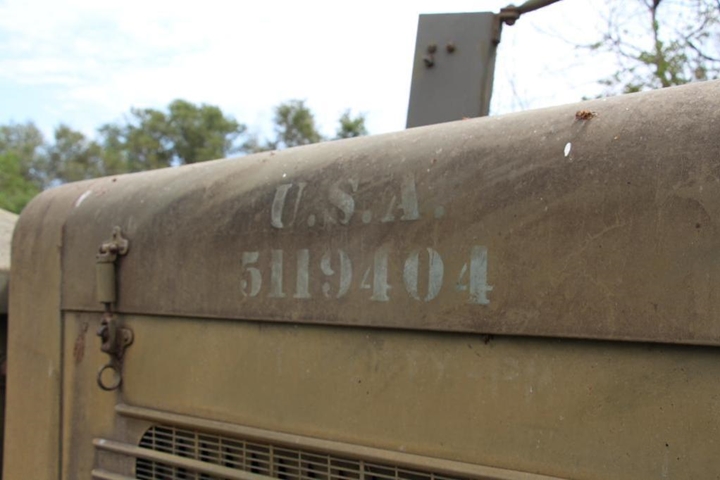
The first of the five digits in the
registration number signified that this was a heavy truck or tractor
over five tons of capacity. Photo via Jeff Lakaszcyck.
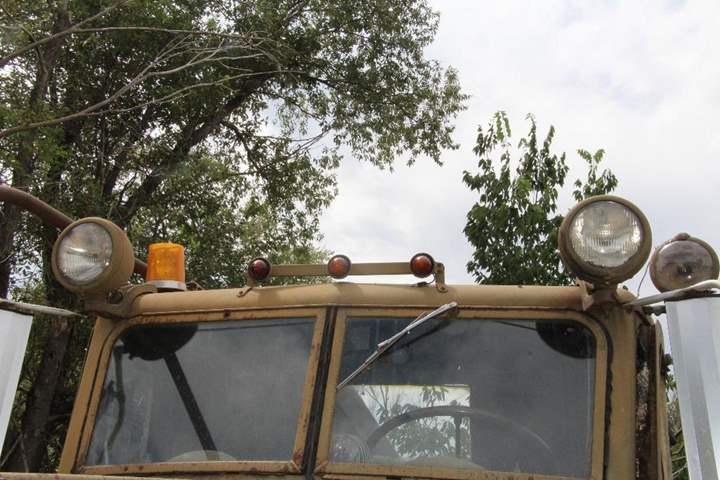
The split windshield and the three
amber lights on a bracket are the same as the Navy truck at Overloon.
Photo via Jeff Lakaszcyck.

Photo via Jeff Lakaszcyck.

The truck has a heater which is unusual for
military vehicles. This was no doubt part of the civilian version
of the truck and the Army Engineers left it in knowing it would be
useful in cold climates. Photo via Jeff Lakaszcyck.
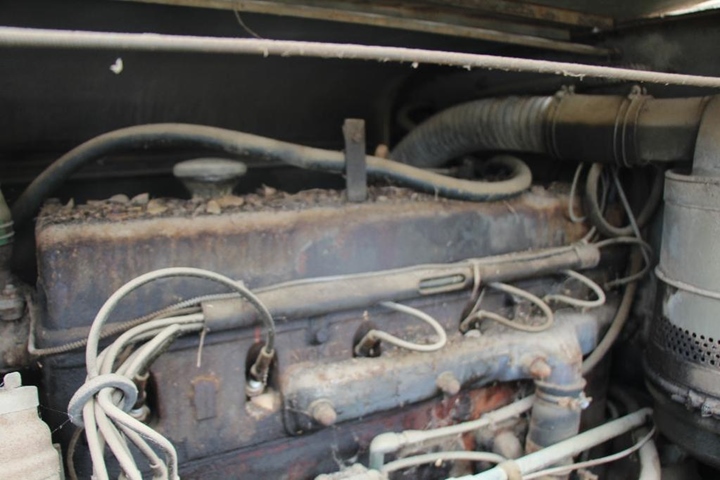
The engine is the Continental 22R, preferred
by the Army Engineers
for its added horsepower. Photo via Jeff Lakaszcyck.
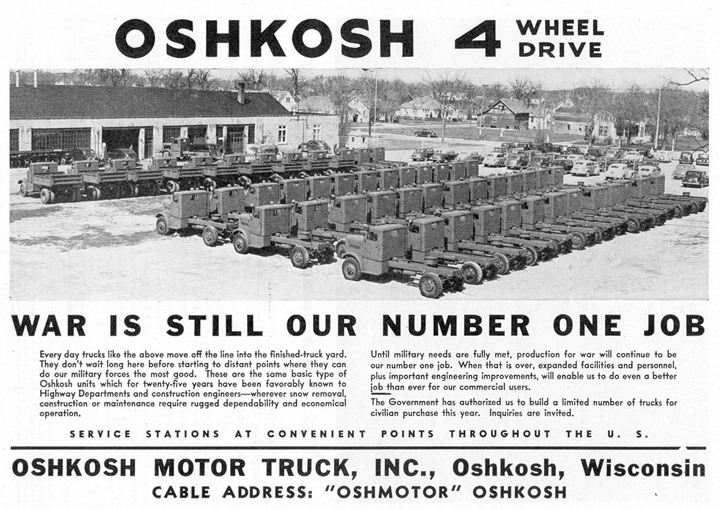
This is a July 1944 Oshkosh magazine
advertisement. There are 52 trucks in the photo. Nine are
dump trucks, which could be part of the order for seventy-six U.S.
Navy 7-1/2-ton dump trucks. They could also be dump trucks for the
Army Corps of Engineers like the one shown above. The other 43 appear to be W-709-C15s that will
become snow blowers for the U.S. Corp of Army Engineers. In 1944
the company built 417 trucks. The 52 shown here represent 12% of
the year's production. It would have taken six weeks for the
Oshkosh Motor Truck Corporation to build these.
With 43 out of 75 snow blower trucks in this
July 1944 photo, it would
strongly suggest that the Gushee family's W709-C-15 was part of another
order for the Corps of Engineers. Image courtesy of Tim Wright.
The Joint Light Tactical Vehicle (JLTV):
In August 2015 Oshkosh won the competition to produce the JLTV as a
partial replacement to the Humvee. To date, over 18,000 have been
ordered from the company.
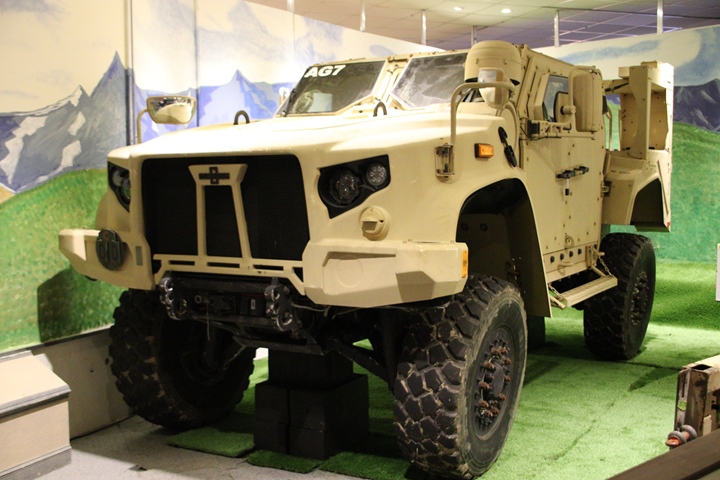
This pre-production prototype is on display
at the Army Transportation Museum at Fort Eustis, VA. Author's
photo added 11-7-2021.
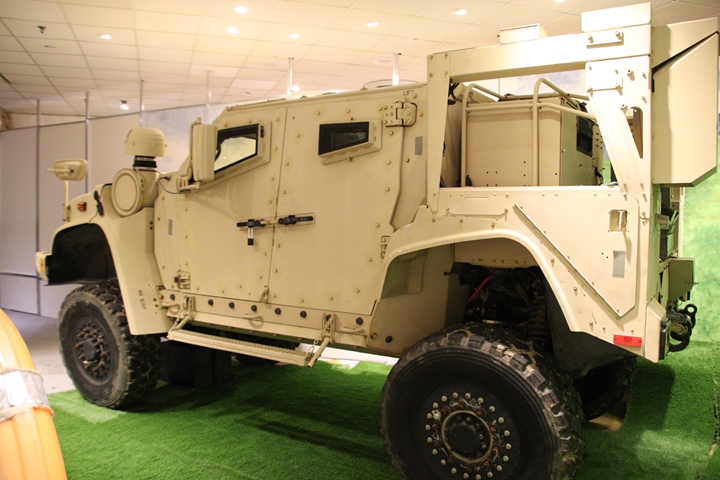
Author's photo added 11-7-2021.
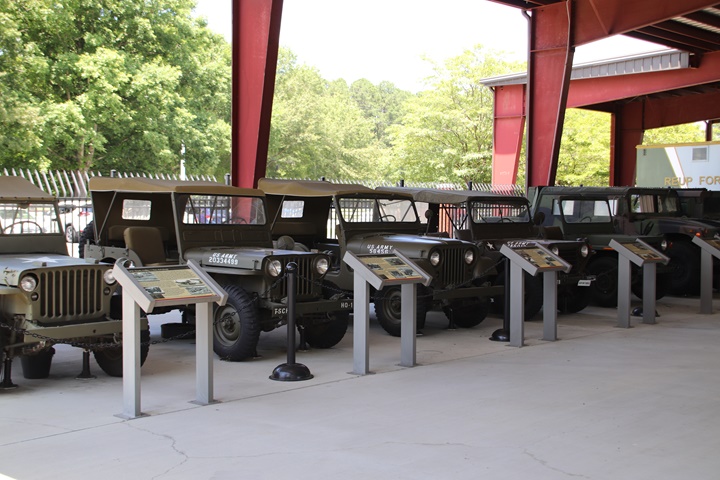
The Humvee replaced the venerable Jeep which
had many versions over its 40 year history with the U.S. military.
Here is the Jeep family in chronological order at the Army Transportation
Museum. Author's photo added 11-7-2021.
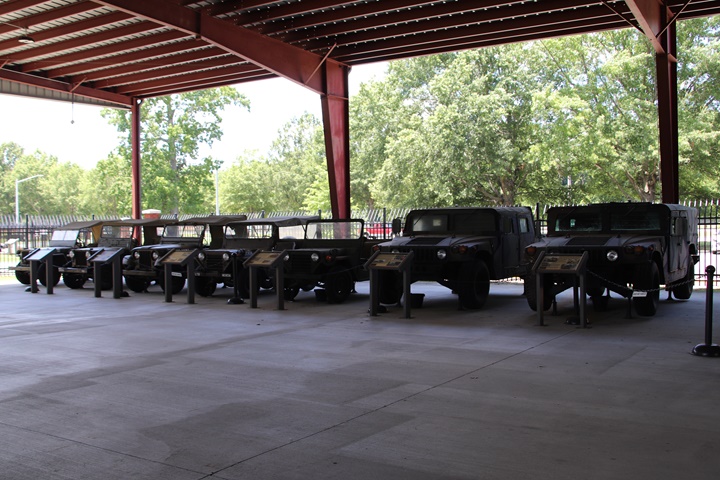
This photo shows both the Jeep and Humvee families. Maybe someday, the museum will add a retired JLTV next to the Humvees. The concept of a light tactical
vehicle has had to change with the times. Author's photo added
11-7-2021.
Current USMC Oshkosh Vehicles:
While visiting the 2019 MCAS Beaufort Airshow, I found the following
three Oshkosh Truck Corporation vehicles on display. All were
7-ton 6x6 Medium Tactical Vehicle armored trucks.
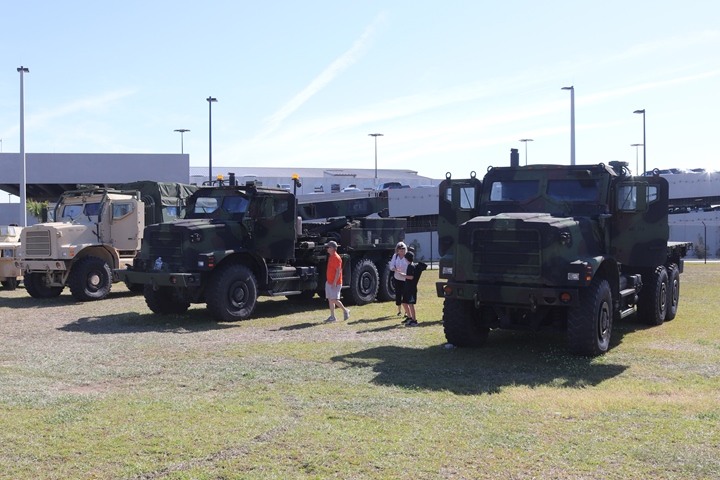
Author's photo.

Author's photo.
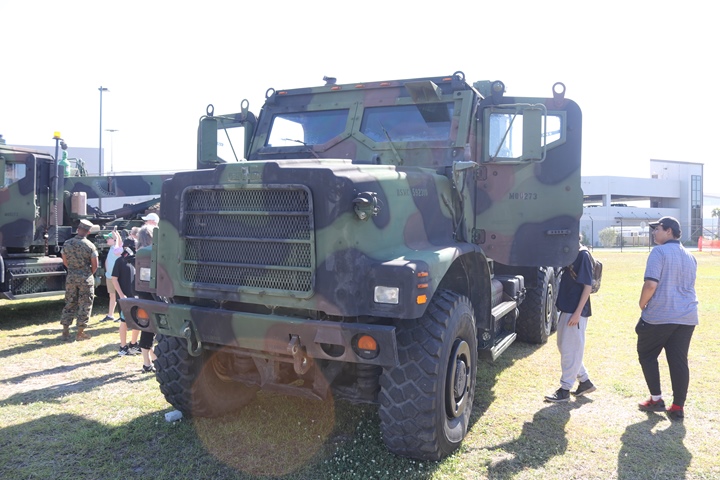
This one is a model AMK-27-A-1-7 cargo truck
with a manufacture date of 12-2001. Author's photo.
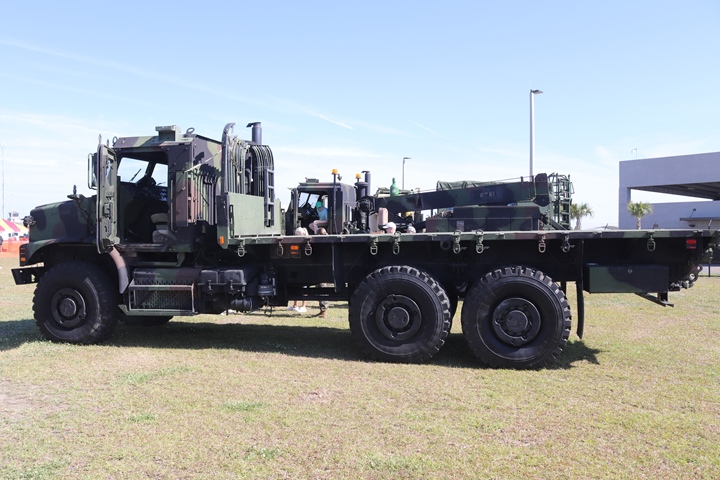
Author's photo.
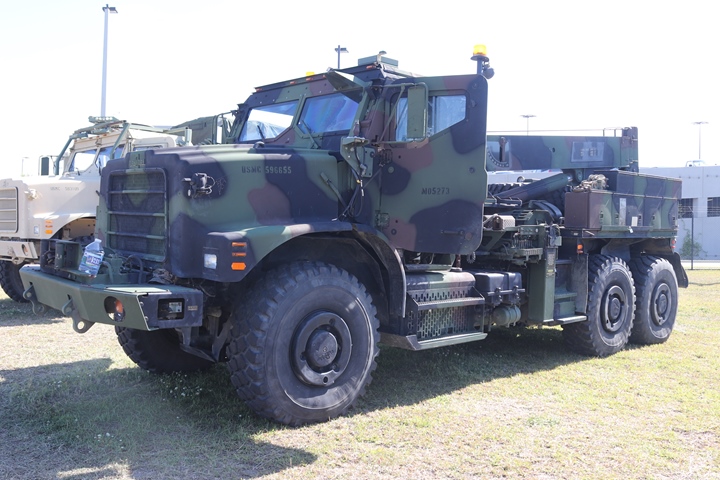
The wrecker version on display was an AMK-36
with winch built during 11-2004. Author's photo.
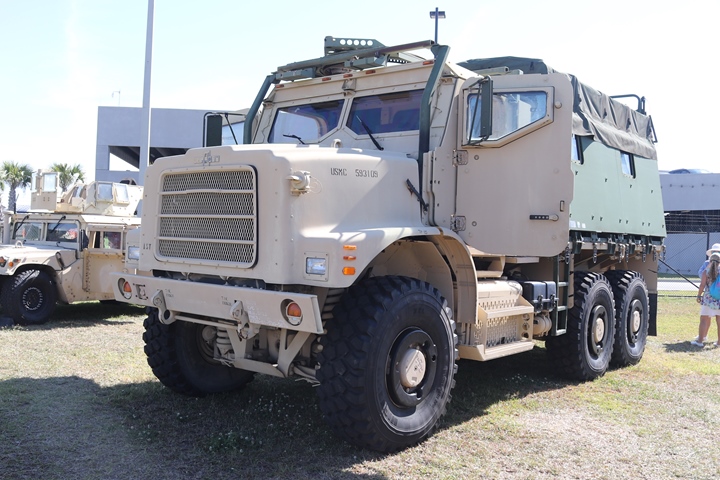
This one is a similar cargo truck but is model AMK-23 that was
manufactured during 9-2013. Author's photo.
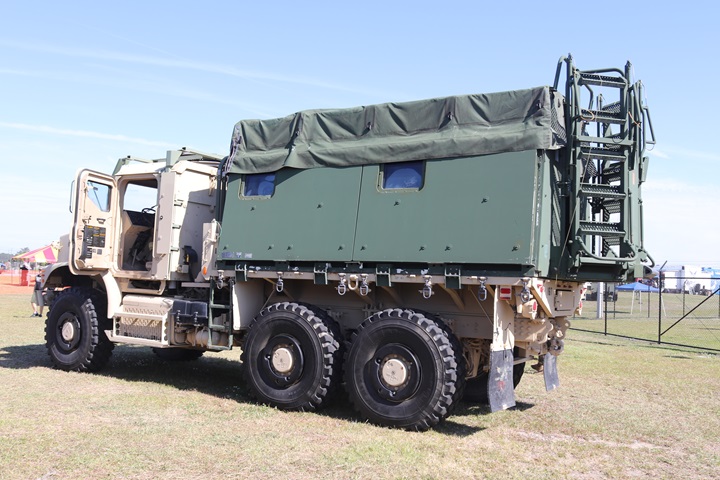
Author's photo.
Retired Oshkosh Truck Corporation Military
Trucks:
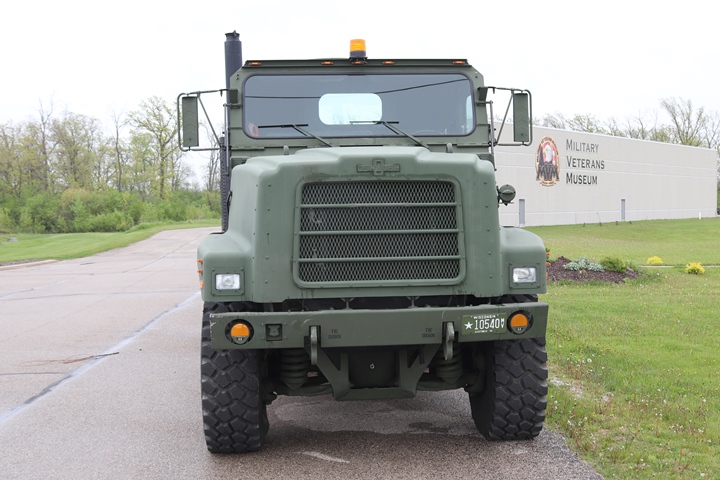
This Oshkosh Corporation M1070 Heavy
Equipment Transporter (HET) is on display at the Military Veterans
Museum in Oshkosh, WI. The museum has registered the vehicle.
The museum is on the southwest side of Wittman Regional Airport and the
Oshkosh Corporation is northeast of the airport.
This truck is five miles from where it and 4,500 others were
built. Author's photo.
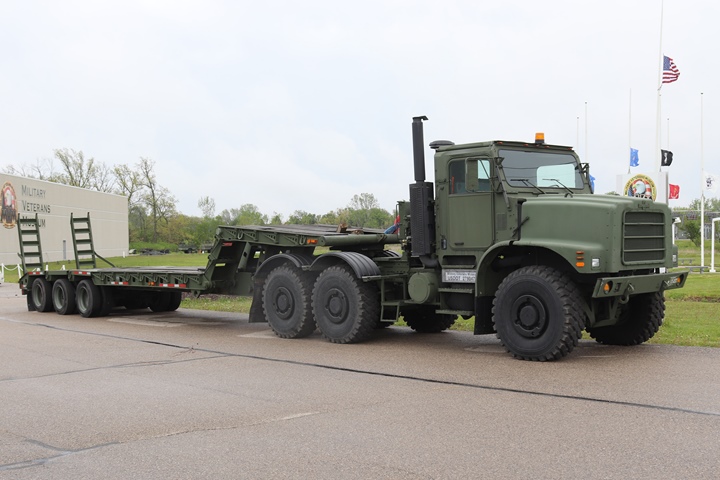
Author's photo.
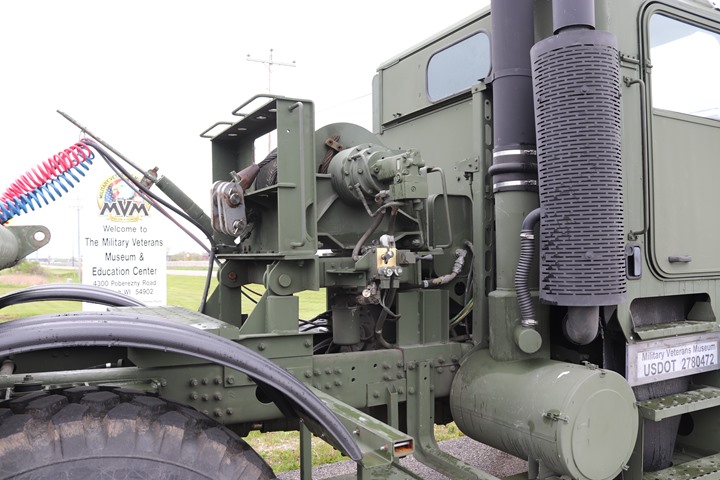
Author's photo.
The following photos were taken at the Russell
Military Museum in Zion, IL. The museum also purchases surplus
military equipment for resale.
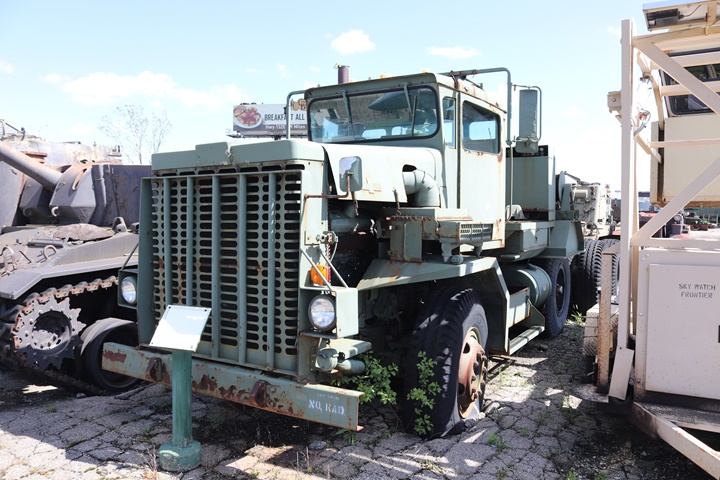
This is the first of the HETs and is an M911
built in the 1970s. Author's photo.
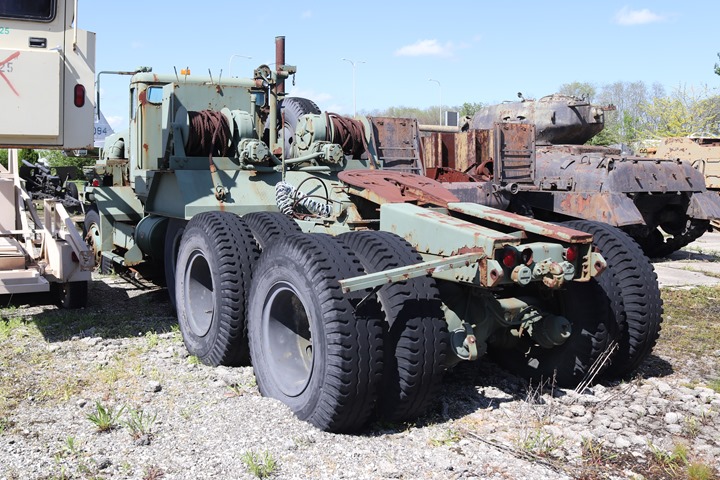
Author's photo.
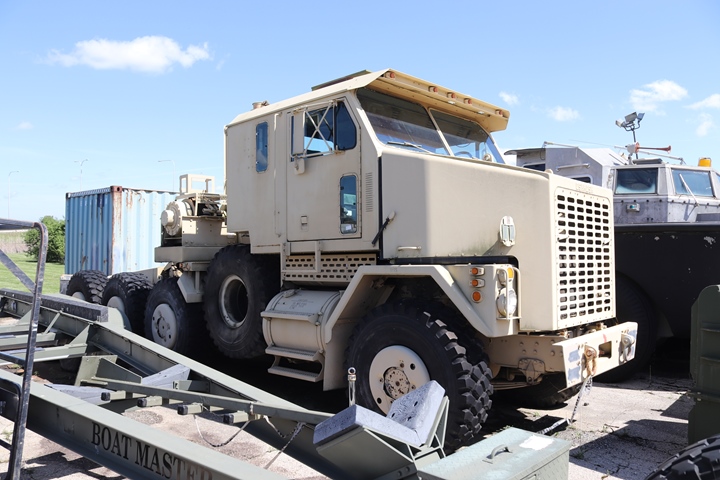
This M1070 HET in desert camouflage was also
out in the equipment yard at the museum. Author's photo.

This Oshkosh M1070 HET is painted in
European camouflage. Author's photo.
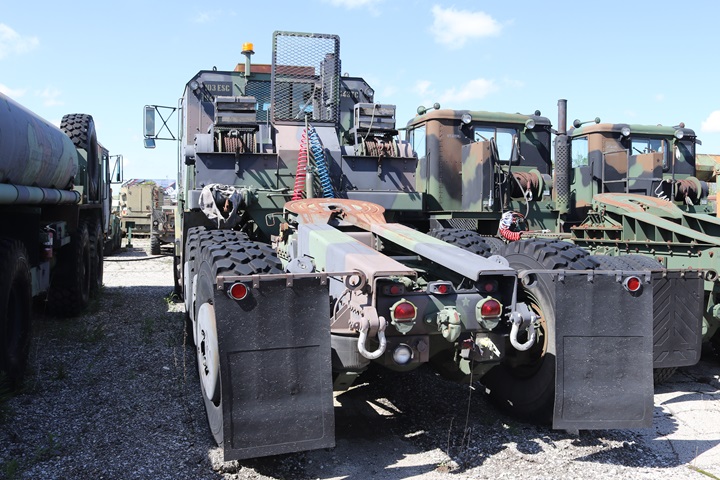
Author's photo.
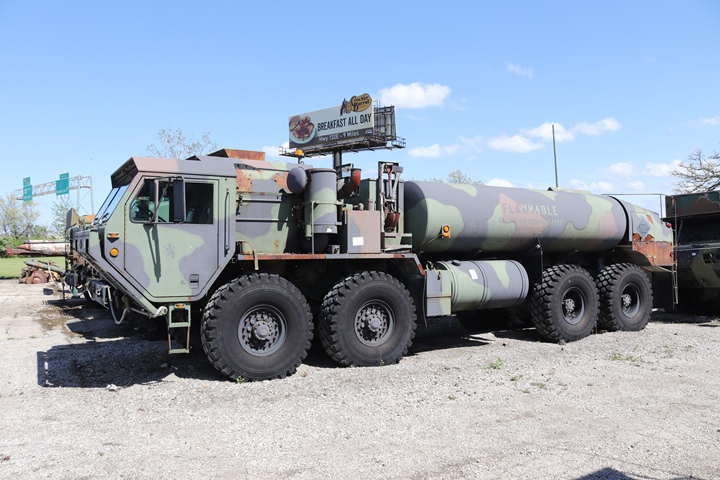
This
Heavy Expanded Mobility Tactical Truck (HEMTT) M978A4 fuel truck is also
in the yard at the museum. Author's photo.
|





















































































